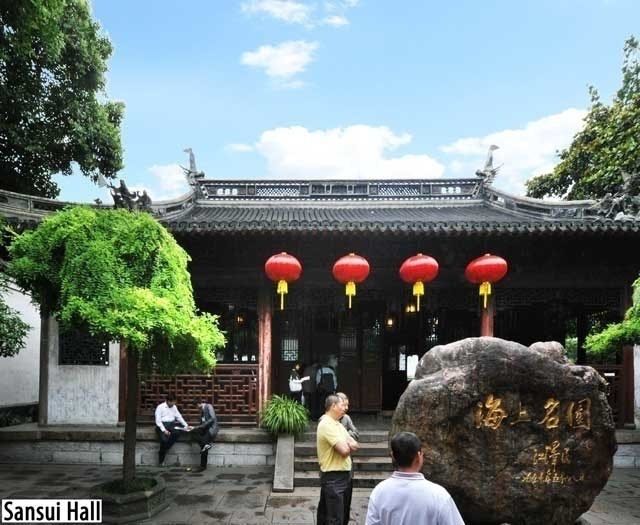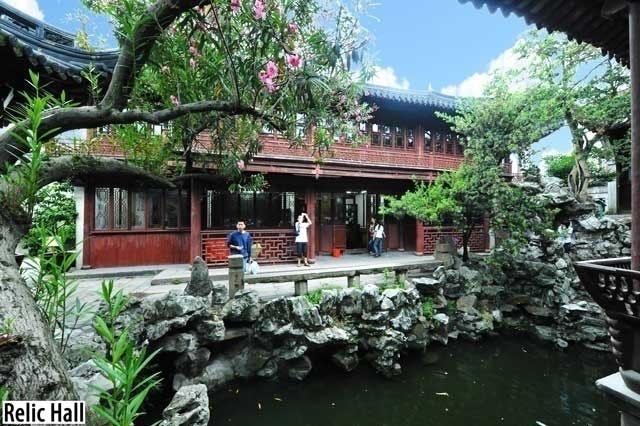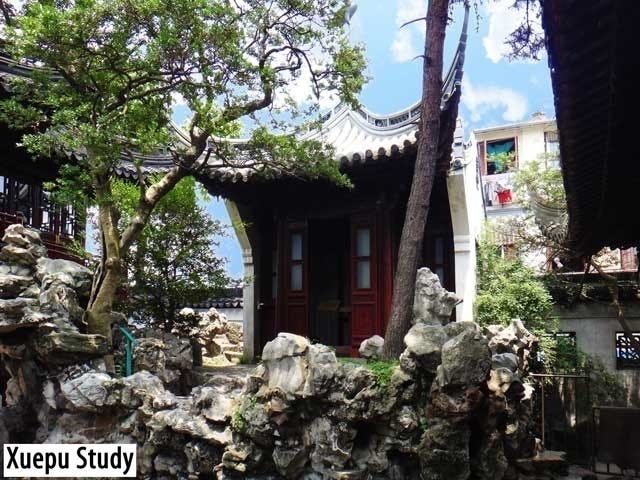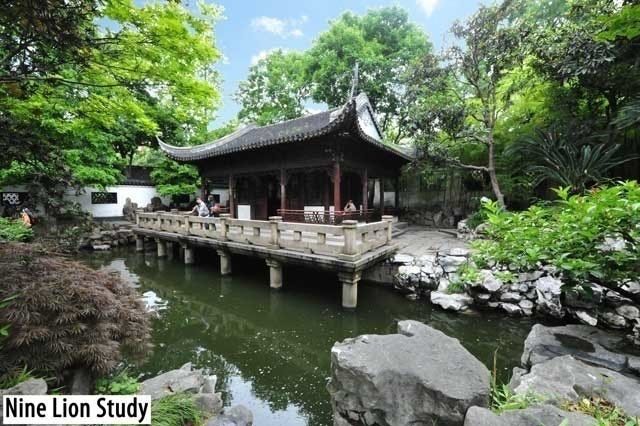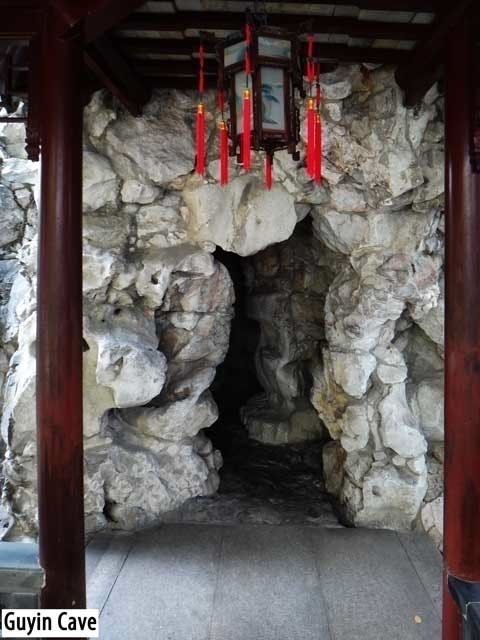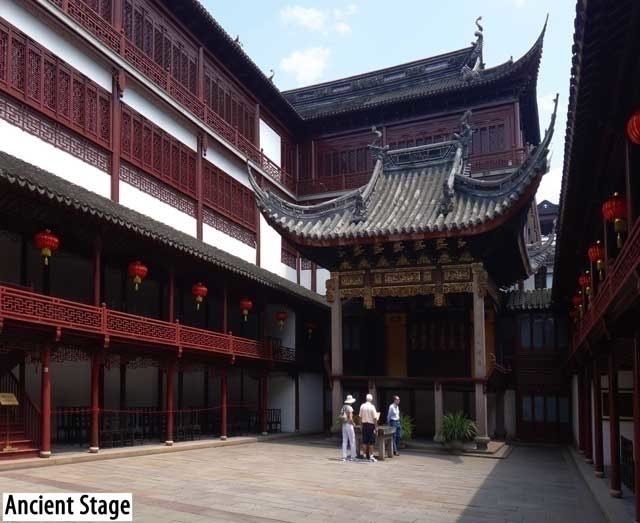The Bund
Mid-Lake Pavilion Teahouse
City God Temple
Lu Xun Park
Jing’an Temple
Jade Buddha Temple
Confucius Temple
Longhua Temple
Oriental Pearl Tower
History of Shanghai
Chinese Cuisine and Table Manners
Chinese Traditions and Customs
Chinese Holidays and Festivals
Chinese Behavior and Etiquette
Peking Opera
Chinese Humor
Welcome to the WanderStories™ tour of the top 10 sights in Shanghai: the Bund, Yuyuan Garden, the Mid-Lake Pavilion Teahouse, the City God Temple, the Lu Xun Park, the Jing’an Temple, the Jade Buddha Temple, the Confucius Temple, the Longhua Temple, and the Oriental Pearl Tower. We are now ready to take you on your personal tour of these world famous landmarks.
We will also tell you the history of Shanghai and several additional stories about Chinese cuisine and table manners, traditions and customs, holidays and festivals, behavior and etiquette, traditional opera, humor and jokes.
We, at WanderStories™, are storytellers. We don’t tell you where to eat or sleep, we don’t intend to replace a typical travel reference guide. Our mission is to be the best local guide that you would wish to have by your side when visiting the sights. So, we meet you at the sight and take you on a tour.
WanderStories™ travel guides are unique because our storytelling style puts you alongside the best local guide who tells you fascinating stories and unusual facts recreating the passion and sacrifice that forged the beauty of these places right here in front of you, while a wealth of high quality photos, historic pictures, and illustrations brings your tour vividly to life.
Our promise:
• when you visit these top 10 sights in Shanghai with this travel guide you will have the best local guide at your fingertips
• when you read this travel guide in the comfort of your armchair you will feel as if you are actually visiting these top 10 sights in Shanghai with the best local guide
Welcome to Shanghai, the largest city proper in both China and the world. It is one of the major financial centers for Asia and home to one of the world’s busiest ports.
Its history goes back for thousands of years, though it is perhaps not until the last thousand or so that Shanghai has been of any significance except to its inhabitants. For centuries a major administrative, shipping, and trading town, Shanghai grew in importance in the 19th century due to European recognition of its favorable port location and economic potential. The city was one of several opened to foreign trade following the British victory over China in the First Opium War, which allowed the establishment of the Shanghai International Settlement. The city then flourished as a center of commerce between East and West, and became the undisputed financial hub of the Asia Pacific in the 1930s.
Today, Shanghai is a popular tourist destination. It has been described as the showpiece of the booming economy of China. There is only one thing to do now – visit!
Let’s go!
Your guide, WanderStories
Once you have read this book please review it, we truly appreciate your feedback.
Please subscribe to the FREE WanderStories™ travel e-magazine, Armchair Travel Guide at: wanderstories.com/travel-magazine
Yuyuan Garden
Address: 218 Anren Road (next to Yuyuan Bazaar)
Start of the tour: at the western entrance 31°13'44.202"N 121°29'14.466"E
![]()

Considering the fact that Shanghai is a financial center rather than a place of imperial beauty, it might surprise you to know that one of the most lavish and celebrated gardens in China is located in Shanghai. The same Shanghai that is a hub to much of China’s financial activity, the same Shanghai that is home to more than 20 million people. To find a piece of idyllic parkland somewhere in Shanghai that to different people is part mist, part swamp, part merry-go-round, part El Dorado, part Promised Land is a mind-altering experience. This pearl of the Orient allows you to experience refinement, harmony, purification, and clarity. Yes, Yuyuan Garden is an embodiment of classical Chinese landscape paintings.

But now we must say that although Yuyuan Garden is often called a park, it’s actually a garden and not a park at all. This distinction is important – a park is much larger than a garden, and Chinese gardens in particular are much more detailed, intimate, and harmonic. This reflects the Chinese sentiment that a garden should be a part of nature and, ideally, imitate it. For this reason, Chinese gardens often contain artificial hills, ponds, fish, and trees all laden with symbolic meanings. All these elements are present in the wild as well. A park, on the other hand, is often a bleak alley, built with modern materials and in modern style, complete with monuments, sculptures, and memorial plaques, lacking in both privacy and connection between people and nature.

In this, Yuyuan Garden is a bit unusual – the once cozy garden has become one of the most popular tourist sites in Shanghai. And obviously, this results in huge numbers of visitors. Because of this, Yuyuan Garden can’t really be called private, not even during the winter.

The garden, also called the “Master of Parks,” is visited by hundreds of thousands of people each year. During summertime, Yuyuan Garden, along with Yuyuan Bazaar, which is located nearby, is the most visited area in Shanghai. The people on the streets remind you of a roaring river. A comparison quite shrewd, really, as water plays a major role in the garden.

Before visiting Yuyuan Garden, Chinese sages recommend you read some Chinese poems or study a Chinese landscape painting – this helps with connecting with the garden. Otherwise, a visitor might not comprehend the refined design or the pure style of the garden. It is said that people who have never read Chinese poetry or studied Chinese paintings should visit Yuyuan Garden three or even four times. Only then can the visitor understand and really see the garden. In a way, it’s like meditating – cleansing and honing the spirit to create the proper mood for your visit.
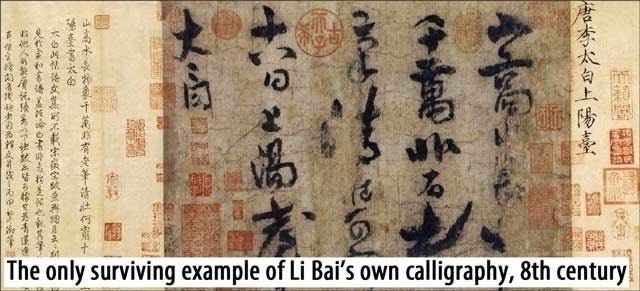
We recommend you read the poems of Li Bai, the famous Chinese poet from the 8th century, for example. Additionally, knowing Chinese poetry will help you understand the names given to the buildings in the garden as many of these names come from famous poems.

A warning, however, to the prospective visitor. One cannot browse through a poem or skim over a painting. Similarly, one cannot run through the garden and expect a stunning experience. You must choose the right rhythm, make frequent stops, try to take photographs from different angles, and most of all – think. You should think about what you see, digest it, and only then move on. Yuyuan Garden is not the Louvre in Paris, with masterpieces packed side by side. In this garden, all details are closely tied to one another. And in order to understand the whole, you need to take time!

Start of the tour: at the western entrance 31°13'44.202"N 121°29'14.466"E

As a rule, we’re used to seeing the entrances to Chinese gardens and parks in their eastern, western, northern, or southern ends. In Yuyuan Garden, the entrance is located in the west, but it lies a bit tucked away. The reason for this is the peculiar shape of the garden. The gate itself cannot be called ordinary, either.

First of all, two dragons top the gate, with fish tails coming out of their heads.

More interesting is the fact that the statues on the roof are not animals, as is usual in China, but human statues.

If you have had the opportunity to visit Chinese temples or governmental buildings, you have seen different animal statues located on their roof corners. Here, you can see human statues instead. And each of these statues is accompanied by a story, one longer and more famous than the other.

In the center of the gate, placed between animals, birds, and plants, you can clearly see two Chinese characters, meaning Yuyuan, or the “Garden of Peace and Harmony.” Very soon, you will be entering through this gate, but for now, let us tell you a famous story about two of the statues on the gate.

Looking carefully, you see on the top of the gate statues of Jiang Taigong and Wuji. These two are legendary people who lived in Central China during the 11th century B.C.E. The one fishing is Jiang Taigong, the first strategic mastermind in China. His wisdom and cunning helped China overcome many enemies. In China, he is as famous as Sun Tzu, the author of The Art of War, is in the Western world.
The story tells that once Jiang Taigong was very angry with the king of his country. Back then China was governed by kings instead of emperors. This continued until the birth of the Chinese Empire in 221 B.C.E. These kings were rulers of the mortal world. The power of a king was limited as he only ruled the people. The emperor, on the other hand, represented the will of Heaven, and stood for all the forces outside the moral realm. Being a true Son of Heaven, the emperor ruled people and the heavenly forces. In truth, he ruled the whole world. As the kings were mere mortals, it stands to reason that many of them were flawed – mortal, prone to errors, weak in character.
The king of Jiang Taigong’s country was a tyrant, and this Jiang could not accept. He decided to leave his home and did so. Once in the neighboring country, he realized that he was a stranger, and the local king did not consider him important at all. He set out to correct that and went down to the river to fish.

He sat down and took his fishing rod but did not attach the bait. He held the hook above the water, saying: “Fish, if you do not wish to live, please, bite the hook!” This behavior was deemed very strange, and people gathered around the river to watch the odd fisherman. One day, Wuji, who gathered wood for the king, passed by and stared at Jiang Taigong for a long time.

He said: “If you continue like this, you will not catch any fish – not even in a hundred years!” Jiang Taigong remained calm. He replied: “I am not fishing for fish, I’m fishing for the king.”
Wuji told the story to the king, who decided to visit the river himself to see the strange fisherman. Soon, the king and Jiang Taigong were getting along just fine, and the king realized that the man was not some weird hermit but a very wise man, and a noble to boot. The king invited Jiang Taigong to join his court, and after some time, Jiang Taigong helped the king cast down the tyrant ruler of his former home country.

Similar stories, legends, and connections are present with each of the statuettes, decorations, poems, and maxims you encounter at Yuyuan Garden. Each detail and element of design has a particular meaning that the garden’s creator Pan Yunduan wished to convey. Truly, Yuyuan Garden will give you a cross-section of Chinese culture and history, a glimpse at holy Buddhist scriptures, Daoist poetry, and traditional paintings. Hopefully, you will also gain some new perspectives. And let’s not forget the simple beauty of it all, well worth capturing with your camera.

Just remember not to hurry. The six areas of the garden are worth every hour spent here!
First Area and the Huge Rockery
Welcome to the magnificent Yuyuan Garden!

Altogether, the garden is divided into six areas, separated by walls, one more interesting than the other.
The first building you see on entering is the Sansui Hall (No. 1 on the map). During the Qing dynasty, this building was used to hold meetings for state officials, scholars, and religious leaders.

As Yuyuan Garden then belonged to the City God Temple, this is eminently reasonable.

Within the Sansui Hall, you meet one of the most characteristic beliefs in China. You are certain to notice a large white stone tablet, covered with glass, in the center of the hall.

The tablet is covered in writing. This is the story of how Yuyuan Garden came to be, written by none other than the builder of the garden, Pan Yunduan, himself, and later carved on this tablet.
In China, it’s customary to have all scenic areas accompanied by pavilions where one can relax and enjoy the view. These pavilions, in turn, are viewed as incomplete without a story of how they were built, written by some high official or a famous scholar. It is feared that without such a written record, memories would be quick to fade. On the other hand, if someone of average ability composes the writing, neither the building nor the view can ever expect to become famous. This white tablet, then, represents the soul of Yuyuan Garden, making sure that the garden will retain its fame.
Just behind the Sansui Hall, you find the Yangshan Hall, or the Mountain View Hall (No. 2). It is also called the Happy Fish Water Side Pavilion.
On the north side of the Yangshan Hall is a balcony overlooking the Huge Rockery (No. 3). This is one of the most picturesque sights found in the garden.

It feels like you’ve entered a painting, and in order to further improve on that impression, the balcony of the Yangshan Hall is built to lean out over the water, in which it’s supported by twelve pillars. The relatively large Yangshan Pond is located in front and below the balcony. Different streams and rivulets connect it to the other ponds in Yuyuan Garden. And in the background of it all towers the Huge Rockery.
The view seems like it’s taken straight out of a traditional Chinese painting. You see an artificial mountain, with the rocks brought here from hundreds of kilometers away.
The still water at the foot of the mountain, the pavilion on the mountain itself, the jagged peak, and the forest covering parts of the mountain – it’s a microcosm of the Chinese landscape, and a favorite subject of Chinese painters. With a little effort, one can even imagine clouds drifting around the peak. Sadly, the artificial mountain is not high enough to attract real clouds.

Such natural harmony is traditional in Chinese gardens. Now, we will tell you the story of how Pan Yunduan created this particular view.
As you entered Yuyuan Garden through the main gates, the first impression was probably one of angst – you found yourself in a closed space, cornered by walls and buildings. It seemed as if the proximity of all those constructions was invading your personal space.

You didn’t feel like taking a breath, enjoying the views, or taking a stroll. While there were trees, flowering plants, or masterful decorations everywhere, they were all somehow too close. Instead of enjoying the view, you may have wished to exit as soon as you could.
Fortunately, this angst passed as you walked through the courtyard in front of the first building, the Sansui Hall, and reached the Yangshan Hall located behind it. Having stopped, you could enjoy a view that is the polar opposite of the first impression. Here, you felt an urge to be a simple fisherman, such as Jiang Taigong, to sit and fish and enjoy the view of the Huge Rockery in front of you. And if you felt so, then remember – catching any fish is actually irrelevant, the important thing is to imitate Jiang Taigong, or in other words, to coexist with nature, in harmony. According to Daoism, one of the most widespread religions in China, this constitutes the ideal way of life.
The average Western workaholics with their speeding on the highways of life may consider it a pure waste of time. Daoists, though, feel that this is the best way to clean and purify one’s mind. It’s one of the ironies of life that we work in order to escape primitivism and thus move further and further from nature, and in doing so, the goal of our efforts becomes to return to a simpler way of living. Or as a story goes – a person living in the country works hard in order to move to the city, and once there, works even harder in order to afford a place in the countryside, where to relax.
But here you are, near the Huge Rockery, safe from hurry and mundane troubles.

Pan Yunduan was a highly educated official with a passion for art. The idea to build an artificial mountain as similar as possible to a real one came from landscape paintings. Desiring a place where he could, for a time, wander among the water, the trees, and the mountains, free from everyday problems, Pan Yunduan set out to build just the place.
In the 16th century, when the construction of the Huge Rockery began, this area was an empty field on the shores of the Huangpu River. Over the years, Pan Yunduan successfully created one of the most idyllic miniatures of nature, one that’s survived to our day!
For Pan Yunduan no obstacle was too great. Even the yellow rocks the rockery is composed of were brought from a special location hundreds of kilometers away.
You may know that artificial mountains as such are not Pan Yunduan’s original idea. No, many of the traditional aspects of Chinese philosophy, customs and religions are tied to such artificial mountains found everywhere in the country.

In appearance, the Huge Rockery resembles the mountainous areas of China, but smaller, of course. To the Chinese, mountains are important for both cultural and historical reasons. Long treks are done in hills and mountains, many are the descriptions of mountains found in literature and art. Mountain peaks are connected to beliefs and religions. Several of such peaks have gained fame through the writings of poets or wise men.

In paintings full with Daoist elements, you can often see wise men meditating or discussing philosophy between mountains wreathed in mist.
An important nuance in such mountain scenes is the vagueness in contours, which helps to express sentiment and obscure the border between plant life and clouds. Perhaps you will have the opportunity to visit Zhangjiajie National Forest Park in Central China, a UNESCO World Heritage Site.

If you do, then you will note that it appears to be the living embodiment of such paintings. The mountains there, in combination with forests and clouds hugging their sides, offer grand views. In ancient China, by the way, clouds were not merely clouds, they were the “water of mountains.”

Coming back to the Yangshan Hall, and the present, you find yourself again on the balcony.

In front of you are the mountains and waters of the garden. The only disadvantage is the lack of clouds as the Huge Rockery is only 14 meters (46 feet) high. Clouds appear in Yuyuan Garden only on very rainy and foggy days, and hopefully, today is not one of them. Still, the connections between mountains and water are rather thought provoking. Mountains and water make up the landscape. The “water of mountains” are the clouds.

As we have mentioned, it would be best if everybody read a Chinese poem or studied a landscape painting before visiting Yuyuan Garden, as the impression one gets is much enhanced by the correct state of mind. Conveniently, a few lines of poetry can be found inside the Yangshan Hall, above the doorway leading to the balcony.

The text says, in Old Chinese, which, by the way, was read right to left instead of left to right as modern Chinese: “In this place are high and rocky mountains, here are tall forests of trees and bamboo, here are slow and meandering rivers; I am surrounded by the harmony of it all.” Standing here on the balcony and looking out at the Huge Rockery, you should get a similar feeling.
Originally, the Huge Rockery included a waterfall, from where water cascaded down until it disappeared under the bridge.

Today, you see the bridge and the pond, but the waterfall has vanished. But still, the view from the balcony of the Yangshan Hall matches the lines in the poem exactly.
Ages ago, when Pan Yunduan was making his plans for this garden, he had a specific vision he desired to create. Or rather, recreate. The view from the balcony matches famous Chinese landscape paintings, dating from the Song dynasty. Let’s examine the view in more detail.

Directly in front of you is a large body of water, beyond which you see tree-covered “mountains” in the distance. While the Huge Rockery is not that high, the illusion of looking at a place very far away is solid. The balcony is located below the peak of the rockery and furthermore, the pond stands between you and the “mountain.”

The most classical of Chinese landscape paintings had to fulfill these three criteria, or three distances. Firstly, a smooth surface leading away into the distance, either land or water. Secondly, the depth that leads farther away into the distance, generally the border between the mountain and the water, or the touching point between the horizontal and vertical lines. Thirdly, the height leading into the distance, or the peak of the mountain itself. In combination, these three distances create a feeling as if the watcher is somewhere very far away from all this.
One must admit that considering the limited space in Yuyuan Garden, the illusion of distance from the balcony of the Yangshan Hall is truly well maintained.

Zhuangzi, a famous Chinese sage who lived during the 3rd century B.C.E., maintained that such places are best for forgetting the worries and the temptations of one’s everyday life and for joining the spirit of nature.

Now, however, a brief return to the wordplay evident in the “water of mountains.” One component very important in Chinese paintings is clouds. Usually, seeing the Huge Rockery in cloud cover demands a strong imagination. In the case of rain, or fog, the effort to see it as a mountain peak among clouds is somewhat smaller. But why, exactly, are clouds so important? According to the traditional Chinese view, clouds are the essence and spirit of mountains. Clouds give the mountains their vitality, and make them alive. Every artist trying a hand with landscape paintings should consider this view. It’s the clouds that make mountains move, become alive, and create the view and the painting as well.

The rocks of the Huge Rockery deserve a few words themselves. They are not stacked atop one another, creating an even slope similar to those in the Alps. No, instead they create a very asymmetrical progression. This is deliberate. The irregularity of the mountain and the imaginary clouds floating between the separate peaks help cement the illusion of living stone. If there was a waterfall at the foot of the mountain, then all the better, the rockery would then be a triumvirate of perfection, offered to you by Nature herself.

There is a stone stairway leading to the top of the rockery, but it is closed to tourists. Today, there are very few people who are allowed to visit the Huge Rockery. The large numbers of visitors would otherwise be impossible to contain.
The stairway gets ever narrower as one ascends. This represents a famous technique also used in paintings – the higher something is, the smaller it should be depicted. Here, the higher something is, the smaller its size. Adhering to this technique helps maintain one of the distance effects mentioned earlier, the effect of height.
If you could ascend these steps, then at the top of the “mountain” you would reach the Wangjiang Pavilion, or the Looking at River Pavilion. Considering the surroundings of the Huge Rockery, the name is apt. The locals say that in the 16th century, when the garden was built, the pavilion looked out on two rivers – Huangpu and Wusong.

Old chronicles claim that the two rivers passing through Shanghai seemed to be so close as to be right next to the rockery. Four hundred years ago the Huge Rockery was a respectable hill. At one point, it was the highest place in the city. In modern Shanghai, though, the farthest one could see from the Wangjiang Pavilion is to the neighboring street.

If you take a close look at the rockery, you notice that the Wangjiang Pavilion at the top is smaller than the Yixiu Pavilion at the bottom. In short, this is another attempt to create an illusion of distance.

The pavilions on the Huge Rockery were built despite the shortage of room in the garden. Pan Yunduan felt that without these, the final effect would be incomplete. Furthermore, in China the tradition is that when one builds an artificial mountain, one must include pavilions, because pavilions are found on natural mountains as well.
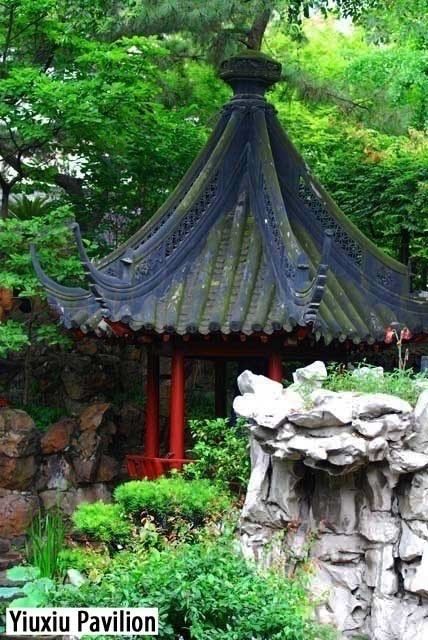
And indeed, whichever mountain you will visit in China, you are sure to see more than one pavilion adorning its sides.

This is a time-honored principle, and one that Pan Yunduan felt compelled to follow. It’s worth noting that the Wangjiang Pavilion is designed for enjoying the view opening to all sides. The Yixiu Pavilion, on the other hand, is designed to offer a place to rest for those who wish to climb the “mountain.”
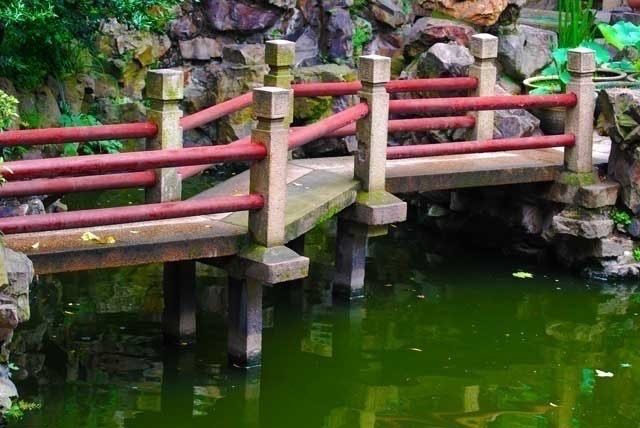
But let us return from the heights and consider the stone bridge that crosses the pond. The famous sage Zhuangzi and his companion Huizi once walked this bridge. They, too, visited this place to contemplate the tenets of Daoism and to enjoy the harmony of nature. The love for philosophy is an inseparable facet of Daoism.

As Zhuangzi and Huizi walked across the bridge, Zhuangzi watched the fish swimming in the water and said to his friend: “Look now, how the fish swim, free of worries.” Huizi replied: “But you are not a fish. How, then, can you know that the fish are untroubled?” To that, Zhuangzi said: “Since you are not me, how can you know that I do not know that the fish are happy and trouble free?” Being less inclined for an argument, Huizi agreed: “True. I am not you. But I do know that you are not a fish, and therefore, you can’t know whether the fish are happy or not.” To that, Zhuangzi had another counterargument, and then Huizi found another crack in his claims, and so on and so forth. It should be noted that it’s likely they never reached an agreement considering the happiness of fish.

But looking at the fish swimming in the pond, what do you think? Are they happy, or troubled with endless questions? Think about it! A brief foray into philosophy is perfectly suitable for this place. And while you’re here, why not indulge in the Daoist worldview?
Pan Yunduan desired to create perfection, contained within the walls of this garden. Although it was a lofty goal, he succeeded. As you visit other parts of Yuyuan Garden, you will probably agree. And there are others who agree as well – the Huge Rockery is a government protected landmark.

Moving on follow the road sign to the Yule Pavilion. This leads to the second area of Yuyuan Garden. On the way, you see two iron lion statues, dating from the 13th century. As Yuyuan Garden was built at the end of the Ming dynasty in the 16th century, these lions have traveled all over China before finding their permanent home here.

After the Japanese invasion during World War II, they were even taken to Japan. Today, these brave travelers are back here, guarding one of the corridors of the garden, the Corridor for Approaching the Best Scenery (No. 4).

This corridor leads to the second area of the garden, again a perfect example of traditional Chinese gardens. These traditions, of course, are different depending on the part of China the garden is located in. For example, a lot of the gardens south of the Yangtze River are built according to one specific rule. According to this rule, the main entrance should lead the visitor into a small inner garden, which is without scenic views. This inner garden might even be seen as a bit depressing.
This approach is demonstrated in the Suzhou gardens near Shanghai, and indeed, in Yuyuan Garden as well. “How so?” you might ask. Did we not just pass through the first area of the garden, which gave a splendid view of the Huge Rockery?
Indeed, the first area does show you the Huge Rockery. In reality, however, the Huge Rockery is located after the corridor; the gate leading to the “mountain” is at the end of the corridor.

It’s common to present views to scenic locations early. These same scenic locations, however, can only be reached after passing through a hallway or corridor. Such is the case in Yuyuan Garden as well. Even the name of the corridor – the Corridor for Approaching the Best Scenery, reflects the fact that it leads the visitor to these scenic locations one step at a time.
It might seem unbelievable, but the step-by-step way of building is actually connected to food. The term itself comes from eating sugarcane. During the time of the Jin State (265-420), there lived an artist who ate sugarcane a bit differently from the other Chinese. That is, he began at the top, which is narrower and less tasty than the lower part. This surprised everybody; they asked, “Why do you eat so?” The artist replied, “This way is better. With each bite, the sugarcane becomes a little sweeter. Gradually, I move on to the sweeter part, and my pleasure is only growing.”
The story of his uncommon eating practices gave the name to the Corridor for Approaching the Best Scenery. Its Chinese name can also be translated as the Step-by-Step into Scenery Area Corridor.
Every step you take leads you closer to ever more scenic parts of the garden. One area in particular is to the right, at the end of the corridor.

This place is the Yule Pavilion or the Pavilion for Viewing Frolicking Fish (No. 5). As the name hints, it is a place designed for watching fish in their natural element. The name was influenced by the story of Zhuangzi and Huizi, who reflected on the trouble-free life of fish next to the Huge Rockery, remember?
Half of the pavilion is located on the ground and half suspended above the water. This design has been used in several gardens in northern, southern and eastern China. Again, the reason lies in historic Chinese beliefs and traditions.
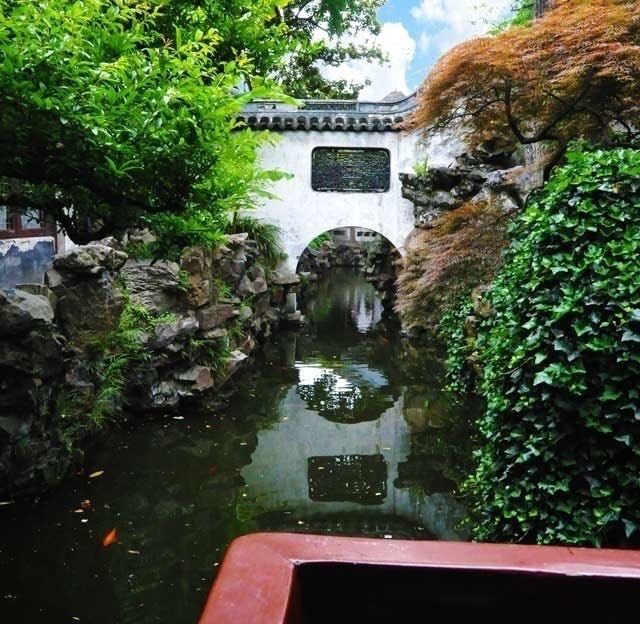
In China, gardens and fish belong together. Firstly, because in Chinese, the word for “fish” also means “prosperity.” Secondly, in China fish symbolize beauty. Thirdly, is it not relaxing to watch fish swim? This is the very scene you can enjoy from the balcony of the Pavilion for Viewing Frolicking Fish. Sometimes, you may encounter visitors feeding the fish. This is a traditional way to ask the fish spirits for good luck.
Next you come to the Relaxation Stone Boat (No. 6), which is rather oddly shaped. Looking at it, you might realize that, indeed, it does resemble a boat. And looking in, you can imagine yourself inside some sea-going vessel.
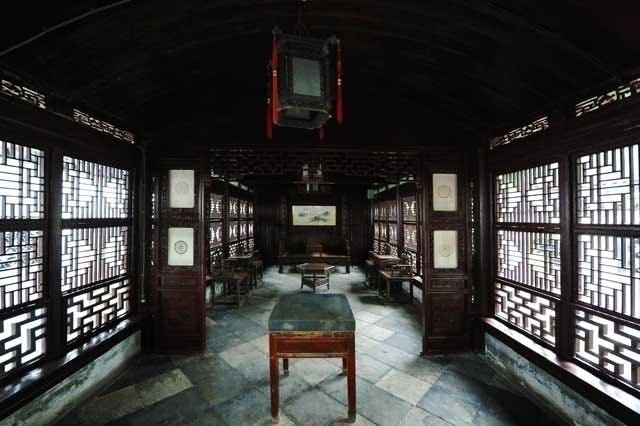
Historically, the Relaxation Stone Boat was a place to merrily spend one’s time. People came here to relax, to hold feasts and to have fun. In a way, it was like a modern cruise ship, with the difference that its point of departure was also the point of arrival, and one could disembark at any time.
But now it’s time to meet the first of several dragons in Yuyuan Garden.

It is situated near the Cuixiu Hall, behind the Huge Rockery (No. 7). The Crouching Dragon, as it’s called, or Wo Long, is a reference to an ancient Chinese story.
In the 2nd century, there lived in China one of the most celebrated military strategists of all time, Zhuge Liang. The feats of Zhuge Liang are told in one of Chinese literature’s most outstanding novels, Romance of the Three Kingdoms, written in the 14th century. And as it happens, the nickname for Zhuge Liang was nothing other than “Crouching Dragon.” It might seem weird to have a dragon referring to a famous, talented, and brave general in such a secluded place.

But in this case, it is not weird at all. In Old Chinese, the characters for “Crouching Dragon” also meant a “wise man living far from people,” or a “hermit.” In other words, the title was used to describe those wise men who felt disgusted with the corruption and greed of the world and chose to separate themselves from it. Additionally, such men often had knowledge that could either help or doom a kingdom. Due to this, their seclusion was all the nobler.
Similar idealized heroism is common in classical Chinese literature and art, but nicknames referring to dragons were reserved for the mightiest of the mighty.

And the dragon, hidden in this farthest and darkest end of Yuyuan Garden, does not expect hordes of tourists, on the contrary, it enjoys true solitude. And anyone who needs help, from the lowliest peasant to the highest emperor, always knows where to search for their best advisor. But without someone pointing it out, an average visitor will probably pass it by, unaware.

The boat ride and dragon viewing complete, you come to another corridor – the Double Lane Corridor (No. 8).

In the center of the corridor runs a meandering wall, effectively splitting the way into two paths, one path narrower than the other.

In ancient times, the wider path was meant for important and respectable people while the servants could only use the narrow one.
Exiting the corridor, you reach the most important building in the second area of Yuyuan Garden – the Wanhua Chamber, or the Chamber of Ten Thousand Flowers (No. 9).

It is sadly not an original and was rebuilt during the Qing dynasty in 1843.

Even its original name has not survived, previously it had been called the Flower Deity Chamber. Both of these names, incidentally, are related to a strange and moving Chinese legend.
The builder of Yuyuan Garden, Pan Yunduan, had a grandson. The grandson’s wife, Yu Juan, loved flowers more than anything, but she also loved her husband. When her husband, Pan Yunduan’s grandson, died, her sorrow was immeasurable. She grieved so long that in the end it killed her. But not long after that, the heavens above the Chamber of Ten Thousand Flowers opened up and accompanied by the rumbling of thunder, hordes of lovers descended. Among them was also Yu Juan, who carried in her hands a basket with flowers. There were also flowers surrounding her, altogether ten thousand flowers fell from the sky that day.

It’s perhaps worth pointing out that in China the number 10,000 also means infinity, or an unimaginable amount.
Those who witnessed this asked one another: “Has Yu Juan turned into a goddess of the flowers?” And maybe it was indeed so. After this event the name of the building was changed. The Flower Deity Chamber became the Chamber of Ten Thousand Flowers.

In front of the Chamber of Ten Thousand Flowers, you again meet nature in its different shapes and forms. Two larger trees, a stream with fish, and another artificial mountain located beyond the stream. One of the trees, a gingko (also known as the maidenhair tree), is more than 400 years old. It is claimed that Pan Yunduan planted it himself.

In China, planting trees, by the way, is an activity laden with different meanings. The purpose of planting trees is to convey the living spirit of someone to something that outlasts him, for example, a tree, in order to preserve it for the coming generations. Since trees outlive humans by far, the Chinese hope that such trees carry the memory of that person and his or her time long after the person has passed away.

The stream flowing below is directly connected to the Yangshan Pond, which you saw in the first area of the garden. Again, this represents striving for harmony, the philosophy being that everything is connected to everything else.

You are probably thinking about the yin-yang symbol, where white is interconnected with black, and each color in turn contains the other? Correct! This is the symbol of harmony, and the same principle is present all around you, here in the garden.
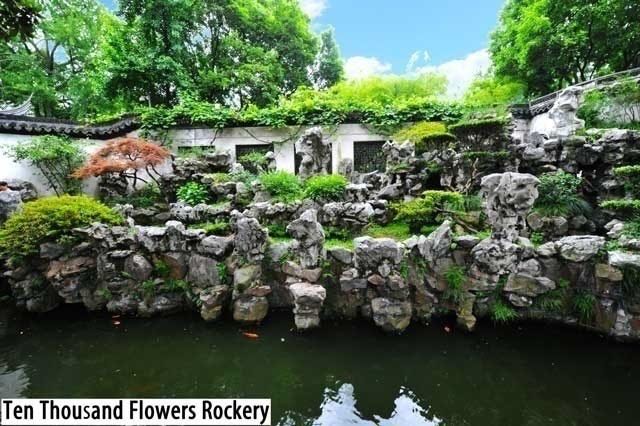
Beyond the stream towers an artificial mountain. While the Huge Rockery is yellow, the Ten Thousand Flowers Rockery is white. As with the other “mountain,” this one contains miniature trees. For the Chinese, “mountains without trees are like birds without feathers.” And as even the smallest of birds have feathers, tiny trees cover even the smallest of artificial mountains in China.
This concludes your tour of the second area of Yuyuan Garden. But you are coming ever nearer to other sites and areas, one more spectacular than the other.
Third Area and the Dragon Wall
Entering the third area, you probably notice that it’s more spacious than the areas visited earlier. You’re right, this area once held the theater grounds and the Dianchun Hall, or the Spring Hall (No. 10), was the main building.

The Spring Hall was the building for the feasts and the audience, where one could spend time partying and watching the plays on the Acting and Singing Stage, which stands opposite. As the name of the Spring Hall implies, the most lavish feasts were held here during the Spring Festival, which for the Chinese marks the arrival of spring and the beginning of a new year. These festivities have come to mean almost two weeks of holidays. The festivities were lavish in the golden days of Yuyuan Garden, as well. Important visitors were received, alcohol was consumed in great quantities, plays and concerts were held, and generally, everyone had much fun.

In later days, the Spring Hall carried different functions. Let’s take, for example, the Small Swords Society, which had its headquarters here in the 19th century. The Small Swords Society staged an uprising in the areas surrounding Shanghai during the Taiping Rebellion (1850-1864). For a time, life in Shanghai was much disturbed by this.

The uprising grew to involve the Qing dynasty, but also the forces of the West. Today, the items displayed in the Spring Hall echo with the sounds of the uprising and the voices of the Small Swords Society.

You can see the coins and weapons from that era.
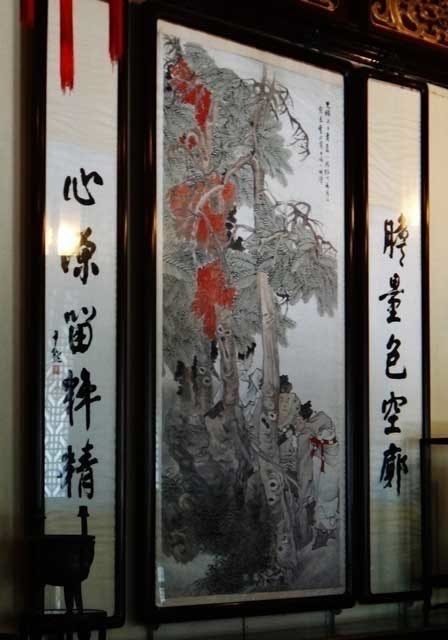
The middle of the building is occupied by a large painting depicting the uprising of the Small Swords Society.

The Acting and Singing Stage opposite, by the way, is one of the most authentic and better-preserved theater stages from the Qing dynasty China.
It’s somewhat contradictory, then, to find out that the third area of the garden was planned as the most silent one of them all...
But there is one silent spot in this area, located behind the Spring Hall and containing three different buildings.
The first is the Ancient Well Pavilion (No. 11).
A larger building called the Relic Hall (No. 12) flanks this. Today, this is the Cang Bao Lou Teahouse. If you haven’t yet visited an authentic Chinese teahouse, then now is an excellent opportunity to do so.
In the teahouse, you may try dozens of different sorts of teas, everyone will find something they like. You can, for example, try one of the strangest-tasting Chinese teas of all – the Golden Lotus tea, or jinlian tea. In Old Chinese, jinlian also means the bound feet of Chinese women. Drinking this most bitter of teas, you might begin to imagine what all the women, with their feet bound, felt like. It is recommended to let the tea steep for a long time, and then to drink it all at once. Another peculiar tasting tea is Tea No. 5, or Sweet Tea, tian cha in Chinese. While Western people drink tea with sugar, or honey, this particular blend is naturally sweet. It’s certainly worth a try, perhaps you feel like bringing a little of it back home with you. Your selection is made easier by the listing of ailments noted next to each tea, every drink here has special curative properties.
The third building here is the Xuepu Study (No. 13), located atop an artificial mountain. Even if you don’t feel like studying right now, this place is still suitable for taking a look outside Yuyuan Garden. If you do so, try to compare these two very different worlds. At first sight, it is impossible to do so. On one side, you have the harmony and beauty of Yuyuan Garden, complete with legends and stories, and on the other, the chaotic, messy and apocalyptic world of today!
Now, let’s take a look at another artificial mountain – the Embracing Clouds Cliff. This is more than an imitation of a mountain, it is built to resemble a rocky cliff. And the Kuailou Pavilion (No. 14), built high atop it, makes it feel uncannily realistic.
If you stop to think about it, it’s quite unbelievable how many different terrains are present in concentrated form in Yuyuan Garden. You have seen bodies of water imitating lakes and rivers; the Huge Rockery, standing for a mountain chain; trees resembling dense forests; plains; and now both a cliff and a gorge. If you think back on what the Huge Rockery looked like, you can now compare these two artificial mountains. Whatever your thoughts, you will certainly agree that they are true masterpieces!
Alongside the Embracing Clouds Cliff, you find the Hexu Hall, or the Hall of Harmony (No. 15). It’s worth visiting, even if only to look at the furniture.

The design of the furniture is unique, the pieces are more than 200 years old. Perhaps they’ll give you some new ideas or thoughts to use back home.
By now, you have surely noticed dragons on the walls, and it’s time we tell you the story of the famous Dragon Wall or Long Qiang.

The Dragon Wall, located here in the third area of Yuyuan Garden, is certain to be one of the most memorable sights in the garden. There are few places in China where one can see so many dragons in one place. And the most powerful of those dragons in Yuyuan Garden are depicted on the Dragon Wall.
The wall can be seen from some way off. The body of the dragon on the wall curves and twists, the dragon itself looks skyward. It seems as if the dragon has been fixed here mere moments before leaping into flight. For this reason, it is called the Dragon Crossing the Clouds (No. 16).

Its prominence is further enhanced by skillful use of materials – the black tiles make up the scales of the serpent, and the white splashes with black dots under them create a splendid color effect. From whichever angle you look at it, it is clearly distinguishable and visible from everywhere in the third area.

The wall surrounding the garden is uniformly white and not so interesting to look at. The Dragon Wall in the third area is, thanks to the dragon climbing atop it, a much more interesting sight. The Dragon Crossing the Clouds continues on in sinuous waves over the entire wall, from north to south.

The head and front claws of the beast are marvelously detailed, and looking up to it, you can almost feel that a few moments ago the dragon was slithering along in some Chinese myth. It appears to hold power over every mortal, and it is not uncommon to stand here and stare at it for a long time.

But the dragon is not alone here. It is accompanied by a worthy friend – a toad. You can see it when you take a closer look under the dragon’s head.

The small amphibian is crouched there, almost invisible. In Chinese traditions, the toad symbolizes longevity. Combined with the power of the dragon, the lucky recipient of their blessing would receive both unimaginable power and incredible lifespan.

Without a doubt, the Dragon Crossing the Clouds is the most famous dragon in the garden and the best looking, as well.

The meanings a dragon holds for the Chinese are hard to overestimate. In order to understand, several questions must be asked. For starters: what is a dragon? As you can see in various locations in China, there are depictions or names referring to dragons everywhere. And yet, nowhere is it explicitly stated what a dragon actually is. It seems an unearthly and mythical creature, and yet it has the abilities of animals and seems like an animal itself. And then there are characteristics, which set it apart.

All things considered, though, you are right if you think that the Chinese dragon is a creature composed of many separate beasts. The debate over which animals are the “ingredients,” if we may say so, of a dragon, is still ongoing, but the most common view is that a dragon is a mix between a snake and a crocodile. In the primitive societies of ancient China, these animals were revered beasts. It is thought that as time passed and nations and cultures mixed with one another, so did their legends and traditions. This may have been the beginning of a supernatural beast with magical abilities we now call a dragon.
On a grassroots level, you should also pay attention to the etymology of the Chinese character for dragon.

The oldest versions of the character long, meaning dragon, have the shape very similar to a snake, to which was added the head of a different animal. For example, the head of a deer, a horse, or a camel.

The modern Chinese character for dragon also contains some hint of a snake’s body and the head of a cow-like animal. In either case, the age of this character is more than 3,000 years. The fact that the beast has remained important through all this time is a clear indicator of how powerful and vibrant the legends must be.
Being a composite of many different animals, a typical Chinese dragon has the head of a crocodile, the eyes of a demon, the body of a snake, the claws of a hawk, the palms of a tiger, the ears of an ox, and the horns of a deer. The dragon is supposed to hear through its horns, its ears being deprived of all power of hearing.
In individual cases, these parts may differ. For example, pictures of dragons often lack the antlers. Furthermore, there are significant differences between how dragons are seen in different parts of China. Such variations are understandable, considering the age of the Chinese dragon. And whatever the actual look of a dragon may be, to a Chinese person the important thing is that a dragon contains within itself nearly all of the animals that bring good luck. Perhaps now you see why the question “what is a dragon?” is so difficult to answer.

If you now study the Dragon Crossing the Clouds, you notice the head of a crocodile, the claws of a hawk, the antlers of a deer, and the ears of an ox. In order to recognize the eyes as coming from a demon, more imagination is required.
All things said, however, the most recognizable feature in any dragon is the body of a snake.
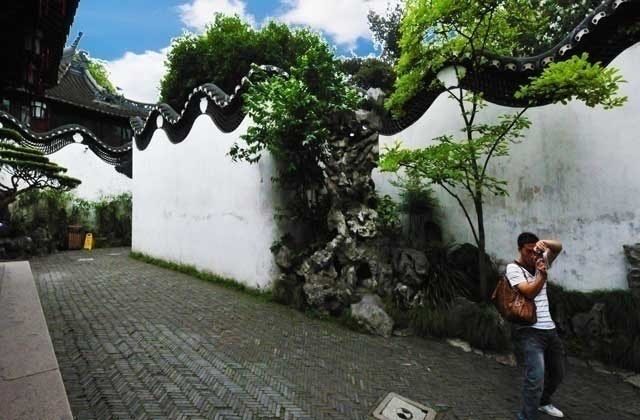
The sinuous shape of a dragon is the first hint of the supernatural. And “supernatural” describes dragons perfectly. Their connections to various animals do not stop at appearance. A dragon can swim, fly, crawl, and walk. It can move about during night and day, in summer as well as in winter. This is the source of a dragon’s supernatural powers and the countless legends surrounding them. Depending on the situation, it will use whatever powers it needs.

To a Westerner, a dragon will appear as a vicious creature that breathes fire wherever it goes and feels neither mercy nor compassion. For the Chinese, however, a dragon is a protective creature that can chase off any and all evil spirits. In Chinese legends dragons have terrorized people only on extremely rare occasions. Dragons are sometimes used in connection to tyranny, but very seldom so.
In order to illustrate the importance of dragons in China, and to show their power, we will retell an old story.

Once, long ago, there was a small village in the Tiantai Mountains. The ground there was so fertile that when stepped on, pure cooking oil was squeezed out of the earth. For many years, the people there enjoyed rich harvests and lived in happiness. But this happiness was not to last. One year, there was a great drought. Not a drop of water fell from the clouds and the fields remained barren. In the heat, the earth was baked yellow and as hard as iron. The people were seriously worried.
Near that village lived a tortoise with supernatural powers. One night, he manifested himself in the dreams of all the villagers, commanding them to bring him rice and meat. The tortoise gave a warning that if his commands were not obeyed, not a drop of rain would fall all year long. The fearful villagers took all their food to the wicked tortoise, who immediately ate it all.
Seeing that the appetite of the tortoise was endless, the villagers became infuriated and decided to try to slay the creature. But as soon as they thought of a plan, the tortoise knew all about it. In his power he commanded that all those who were responsible for the plan come before him. As soon as the men showed up, the tortoise ate them all. But still he needed more.
The tortoise could not accept the idea that the puny peasants had refused to serve him, the mightiest tortoise in the land. Full of anger, he went to see the Queen Mother of the West, who commanded the god of Thunder and Rain.

The tortoise told her that the villagers in the Tiantai Mountains had refused to worship heaven and earth and had even insulted the Queen Mother herself. This, obviously, was a lie. But the Queen Mother did not know that, and immediately she ordered the god of Thunder and Rain that for ten years no rain should fall on the blasphemous village. This led to an even greater drought, and soon there was hunger.
Luckily, the mountains near the village were home to a dragon, who one day happened to overhear the crying and wailing coming from the village. The dragon turned itself into a young boy and went to see what was the cause. The dragon/boy asked an old woman what had happened and heard the full story of the evil tortoise. This made the dragon very angry, and he decided to make things right. But although the fury of the dragon was great, he could not simply kill the tortoise. Instead, he came up with a cunning plan. He decided to sneak into the Temple of Rain in the Celestial Palace. Within the temple was held a mystical bowl, full of holes, which was used to bring rain.
The first part of his plan went smoothly. He crept into the palace, found the bowl, and hid it about himself. But then, upon exiting the palace, he ran into none other than the tortoise himself! The tortoise immediately realized that something was wrong. With one glance, he also noticed that the dragon, still disguised as a boy, had something hidden under his clothes. Even the wind was against the dragon – just then, a gust blew his coat open, and the tortoise saw that he was stealing the bowl of rain. “How dare you, dragon, come to the Celestial Palace and steal our treasures?” he roared. “I shall immediately go to the Queen Mother of the West and tell her of your insolence!” This, the dragon could not allow to happen, and his only option at that point was to engage the tortoise in combat.
The battle took place in the sky above the village. The fighting was fierce. The tortoise was mighty indeed. In order to help and support the dragon, the villagers started to beat their drums and burned incense.
Soon, the dragon was almost overcome by the tortoise’s power. To save the villagers, he decided to throw the bowl down, into the mountains. Falling, the bowl broke, all the water within it ran out to the fields, and the villagers were saved.
By that time, all the gods had noticed the battle. They quickly took word to the Jade Emperor, who summoned a council to investigate the reasons for the fight. Soon, the truth was unearthed and the Jade Emperor had the evil tortoise thrown in prison and the noble dragon rewarded. Ever since that time, the dragon is considered the god of Rain of the Tiantai Mountains who will always try to help the villagers.
Similar stories, where dragons stand up for simple villages and peasants, are everywhere in China. Often, they contain examples of the dragon’s transformational powers, as in the story you just heard, where the dragon changed his shape into that of a young boy. And it goes without saying that dragon stories always contain battles. It’s in the nature of a dragon to be brave and fearless!

As a symbol, dragon is inextricably linked to Chinese culture and society. Throughout history, dragons have symbolized the emperor. As you know, the Chinese had to worship their emperor and honor him in everything they did. The common people as a whole were the property of the emperor. This boundless submission was even expressed in their hair, which was cut according to a nationwide standard. The whole nation firmly believed that the emperor had the powers of a dragon. He could feed his subjects, bring rain, win wars, and so on. In short, the emperor was a dragon.

This view is particularly evident in the Qing, the last Chinese dynasty. Even their flag held a huge dragon.

Of course, only emperors could wear clothes decorated with pictures of dragons. Common people were strictly prohibited from doing so.

Imperial furniture often contained images of dragons.

And emperors were sometimes depicted together with dragons.
Draconic abilities, you see, were the emperor’s and his alone. And it seems that this approach, where the emperor claimed to be someone he was not, made it easier for him to rule the country.
The Chinese are sometimes called descendants of the dragon. Even in international affairs, China is often referred to as the “dragon country.” Now that you know more about the Chinese dragon, it seems to make a bit more sense, does it not?
But let us return to the present time. There are still more dragons to see in Yuyuan Garden, and two of them are located also here, in the third area. Unlike the others, these two are together.
They can be found over the gate between the third and fourth areas (No. 17).

The dragons here play with a pearl between them.
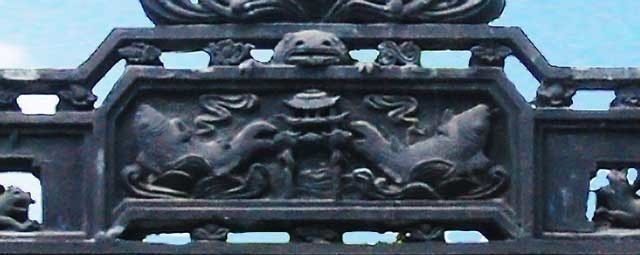
Underneath them are swimming fish.
This, too, is a reference to a story. According to a well-known Chinese legend, fish desire to be dragons. And that, as strange as it seems, is actually possible. All they need to do is successfully leap over a dragon gate. For this reason, as soon as spring has arrived, they swim high upstream in the Yellow River to the Dragon Gate and start making their leaps. Whoever makes a successful one, turns into a dragon, but those who fail remain fish. Mildly put, it’s rather difficult as the gate is high and the dream of achieving dragonhood far away.

In Confucian China, the expression “jumping the dragon gate” was used to represent students who passed the scholar’s exam. Nowadays it is used, in general, as a symbol of a great life achievement achieved through hard work and perseverance.

But to you, as a visitor, this story holds good omens. It is said that those who pass through a gate or doorway decorated with dragons may turn into a dragon themselves, receiving all the powers of a dragon. And that list includes longevity, special powers, riches, and boundless happiness. Give it a try, perhaps you will succeed where the fish failed!
Now, through this remarkable gate with two dragons, let’s head on to the fourth area of Yuyuan Garden.

The fourth area of the garden is even roomier than the one you just left behind. Since the main element of the fourth area is water, you will encounter many ponds and bridges. The bridges are curved and meandering, and they connect different buildings and scenery areas.
Up to now, you have seen at least one body of water in every area you have visited in this garden. Now, there are many more.

As an element, water is very common in Chinese gardens. Each garden holds some kind of pond, around which various pavilions are built. There is a pond in each area of Yuyuan Garden. This is the classical “water in the middle, buildings around it” style commonly used throughout China. It’s the most ubiquitous in South China, perhaps because of the Yangtze River. The Yangtze divides China into two parts, the North and the South. Likewise, the people are divided into two: the Chinese north of the Yangtze, and the Chinese south of the Yangtze. This distinction is evident in almost every aspect of life. They speak different languages, they differ in their customs and appearance, and even their philosophies are not the same.

On your way you go through an interesting corridor.
Next, you reach the Nine Lion Study (No. 18), which is partly suspended over the Nine Lion Pond.

From here opens a beautiful view over the fourth area of the garden.

To the east of it stands a small grove of bamboo, the only real forest in all of Yuyuan Garden.
This is perhaps the wildest area in the garden. The building and the grove together imitate an idyllic scenery familiar from Chinese paintings – a lonely house, home to a Daoist poet or artist.

Although the builder of the garden, Pan Yunduan, was Buddhist, he strongly supported the Daoist philosophy. His interest in poetry and painting is evident everywhere in the garden, every detail is carefully designed and placed in order to create the Daoist ideal of humans coexisting with nature, in harmony. Like so many other places in the garden, the Nine Lion Study succeeds in this.
The imaginary center of Yuyuan Garden is located in the Huijing Tower, or the Scenery Gathering Tower (No. 19).

It’s not the highest building in the garden, but from the second floor, when the garden was built, one could get a beautiful overview of the whole garden, unobstructed.

Next, you come to the Toasting Pavilion, or Floating Wine Cup Pavilion, or Liushang Ting (No. 20).

A one-time owner of the garden and his friends used to visit the pavilion to drink wine and read poetry, hence the name.
Have you heard about a wine drinking game very common in ancient China? In Chinese, the game was called liushang, the same as the pavilion in front of you, which translates to floating cups. If you don’t know, then on the third day of the third month of the lunar calendar, friends would meet near some meandering river and sit down. One of them would place a filled wine cup in the river, and the others would wait downstream. The person near whom the cup touched land was the winner and could drink the sweet wine.

Alternatively, if the cup was about to tip over, the nearest player could pick it up and drink the wine. This game was truly popular in China, especially among the more educated, who often played a variant where the one emptying the cup was also required to compose a poem.

This wine game spread to other counties as well; to Korea, for example, where it gained great popularity. A clever game, don’t you think? And all you need in order to play is a river, some wine, and good company.

In China, bodies of water are present in every garden. The same can be said for mountains.
Here, as well, stands another artificial mountain, called the Huanyun Rockery (No. 21). Translated, huanyun means to wash the clouds. The name is explained when you look into the pond in front of the mountain and see the reflections of the sky and the mountain. If the sky is cloudy, the clouds appear to be floating in the water around the rocks and the rocks “washing” them!
Since Yuyuan Garden was for some time under the rule of the City God Temple, it shouldn’t be surprising to see clear signs of that time here.

For instance, the Laojun Temple (No. 22), which is dedicated to Laozi, the founder of Daoism, who lived in the 6th century B.C.E.

In order to reach the next area, you must cross a stone bridge.

And then go through a round passage, displaying the words yin yu above. Translated, it means leading to exquisite jade. The name is apt, standing on the bridge and looking through the opening, in the distance you see the Exquisite Jade Rock, which is actually in the next area of the garden.
The purpose of the passage is to focus the eye of the visitor, placing the Exquisite Jade Rock in a set framework.

The area you are about to explore is the richest of all. Without exaggerating, one can say that the fifth area contains the most interesting and beautiful places of the whole garden.
First, you reach the Yuhua Hall, or the Hall of Jade Magnificence (No. 23), where Pan Yunduan used to read and study.
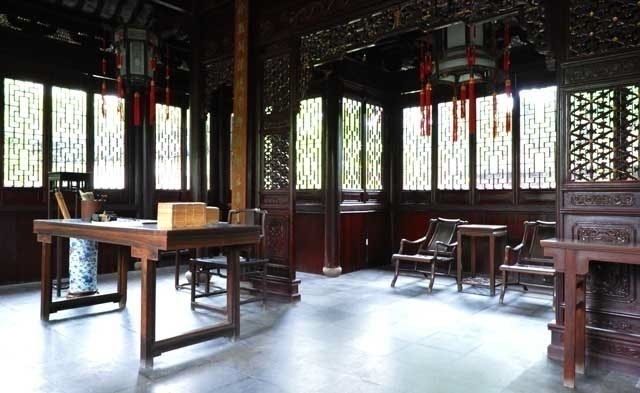
Even today, the Yuhua Hall is home to a reading room dating from the Ming dynasty.
Growing bored of the books or tired of studying, Pan Yunduan needed only to look out the window. Then he would have seen the Exquisite Jade Rock (No. 24), a masterpiece carved by nature itself, located on the other side of the pond.
This rock, which is 3.3 meters (10.8 feet) high, is one of the most famous stone formations in all South China. Carved by flowing water over a long period of time, it is different from every angle. Even as the light changes, the rock becomes different!

Beside the Exquisite Jade Rock, there are two smaller rocks, meant to emphasize the height of the Exquisite Jade Rock, which stands 5.1 meters (16.7 feet) above the pond and the overall look resembles a mountain peak. The location, in turn, adds its own magic to the scene, the rocks seem much higher than they really are.
If you think that these rocks were probably brought here by the builder of Yuyuan Garden, Pan Yunduan, you are correct. The original location of the Exquisite Jade Rock was on the eastern shore of the Huangpu River, which flows through modern Shanghai.

There, where today stand skyscrapers, stood a temple. The family of Pan Yunduan’s younger brother’s wife, Xu Pei, oversaw this temple. After Pan Yunduan’s brother and Xu Pei married, her family gave the rocks from the temple grounds to their new relative so that he might use them in his garden.

However, transporting the Exquisite Jade Rock across the river to the garden was not easy. On the important day, a storm struck the area and the boat ferrying the rock across capsized. Both the boat and the rock were lost to the river. Finally, the rock was rescued from the bottom of the river, but as it weighed six tons (13,000 pounds), it was an extremely difficult undertaking.
The ground route was no less challenging. In order to transport the beautiful rock to its destination at Yuyuan Garden, the wall around Shanghai’s Old City was broken and a new gate built. The gate was named the Small Southern Gate.
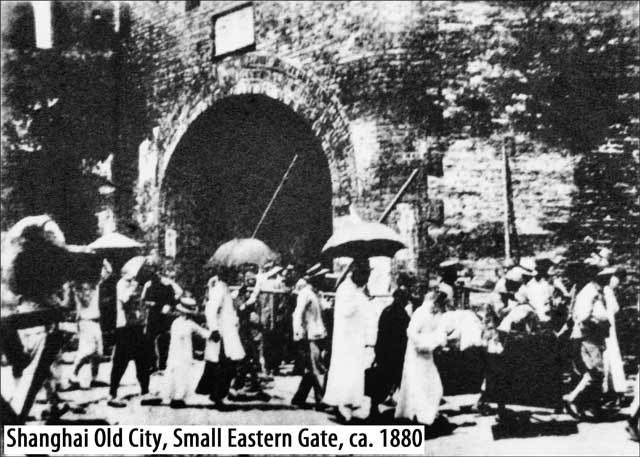
Imagine that, a part of the wall was demolished just because a rock had to be moved! All for the simple reason of moving a masterpiece of nature to its new home. This fact should help you better understand the magnitude of Pan Yunduan’s work, the importance of Yuyuan Garden, and the value of the Exquisite Jade Rock.

The mystery around the Exquisite Jade Rock is not yet done, however. It is said that if you burn incense on the Exquisite Jade Rock, each of the 72 holes in the rock will start to smoke. And, if you place a watering can on top of it, water will start pouring out of the holes in the rock. Who would not want a rock with mystical, even supernatural abilities? Indeed, Pan Yunduan was a lucky man to have acquired a natural wonder of such appearance and character.

Behind the Exquisite Jade Rock, you see a stone wall. Similar to the city wall that was torn down to allow the Exquisite Jade Rock’s entry into Shanghai, this wall also commemorates the importance of the stone. On the other side of it stands the West Gate of Yuyuan Garden. The meaning is not only symbolic, however. In Chinese gardens, gates, important buildings, or scenic locations are accompanied by defensive walls. Similar walls can be seen in hutongs of Beijing, but they are far from rare also in South China.

In the case of Yuyuan Garden, the purpose of the defensive wall was to create a certain effect – an effect rather like you experienced when you entered the main gate and moved up to the Sansui Hall. The desired outcome was the impression that the visitor was surrounded by walls and buildings on every side. On the other side of the defensive wall, stood a broad scenic area. Here, when entering from the West Gate, the visitor would first see an empty area but then pass the defensive wall and see the Yuhua Hall, the pond, and the Exquisite Jade Rock – one of the most worthwhile sights in the garden.

On the wall, you see four Chinese characters inscribed on the stones: huan, zhong, da, and kuai. Translated, this means, “Happiness within the vicinity of the Zhao Wall.” The quote comes from Buddhist scriptures, and in this garden, it has a special meaning. The Zhao Wall marks boundaries separating territories governed by Buddhist laws from others. In effect, this sets aside a part of the garden where Buddhism rules supreme. As you may recall, Pan Yunduan was a Buddhist. It’s to be expected that he would try to connect a part of his beloved garden to the religion in his heart.

On the eastern side of the Yuhua Hall, you find one of the most interesting places in Yuyuan Garden. As seen from afar, it’s a rather dark place. Here begins the Jade Water Corridor, which makes a right turn and finally crosses the pond.
The corridor passes through an artificial mountain, recreating in the garden another sight seen in nature – caves. And indeed, it is very cave-like.
This Guyin Cave (No. 25) is unique. As the story goes, it is closely tied to poems of Lu You, dating back to the Song dynasty in the 12th century.
The poem goes like this: “I am surrounded by high mountains; And rivers, meandering; I feel my feet have left the path; Suddenly, there are flowers, and trees abloom; I have reached the village.”

Entering the Guyin Cave, you might lose your bearings.

But before you can begin to feel scared, you will have exited the cave and returned to the lush garden.
Next, you see the Ting Tao Tower (No. 26), built for a single purpose, so that people could listen to the sound of the Huangpu River.

Translated, ting tao means, roughly, listening to big waves. The reason for the tower is, again, the search for harmony. Yuyuan Garden contains places both for looking at and listening to the Huangpu River. Another step closer to the perfection Yuyuan Garden strives for.
In addition to listening to the sounds of nature, the Ting Tao Tower is also famous for its carvings.

Take a look at the east and west sides of the tower, and you will see stone carvings of famous Chinese stories. The four stone carvings on the west side tell a story “Fisherman, Woodcutter, Farmer, and Scholar.” This story has helped bring up generations of farmers, for whom the story is meant.
In China, agriculture has always been very important, and these stories are relevant even in modern times. The story was also used to teach children to read and to motivate people to learn. Learning has always been and still is highly valued in China.

The other story is about the eight immortals. The stone tablets with these carvings are located on both sides of the tower, so if you want to see them all, keep this in mind.

The story tells of the eight immortals who wished to visit an island. The way there, however, was across the stormy Eastern Sea. The only possible way of crossing the sea was to cast into the waves a treasure of great magical power. So, each immortal had to give up something. One of them threw down a sword; the second, a bamboo flute; the third, a lotus blossom; and so on. Once all eight of the immortals had thrown down their treasures, they could cross the Eastern Sea and reach the island.
It is said that pictures that tell this story have magical powers to help people. Perhaps these stone tablets have these powers as well, who knows?

The third story, found on the west side of the Ting Tao Tower, tells of the famous king of Shu Kingdom, Liu Bei, who married Sun Shangxiang in the Ganlu Temple.

The story is known by almost every Chinese as Liu Bei is a principal character in the world-famous Romance of the Three Kingdoms, written in the 14th century.

In the novel, Liu Bei symbolizes a noble ruler with Confucian views. If you have ever read Romance of the Three Kingdoms, you will perhaps recognize the story.

Inside the Ting Tao Tower, you see calligraphy, paintings, and other cultural relics from the Qing dynasty.
While Yuyuan Garden is not a museum, visiting the exhibition room for a small preview of these historic objects is certainly a welcome detour.
Now let’s take a stroll down the Jade Water Corridor (No. 27). This corridor is the longest ever built in the ancient style of South China. You will surely notice that the corridor is named after jade. In Chinese, the word for jade is yu, and you find it everywhere in the fifth area, for instance Yuhua (Yuhua Hall), Jiyu Shuilang (Jade Water Corridor), Yu Linglong (Exquisite Jade). All of these names have some connection to jade.
The Hanbi Tower (No. 28), located at the other end of the Jade Water Corridor, will likewise offer a pleasant surprise. Firstly, we have to point out that it is built out of special nanmu wood imported from Myanmar, previously known as Burma. This material was often used in shipbuilding, but also in housing and carving.
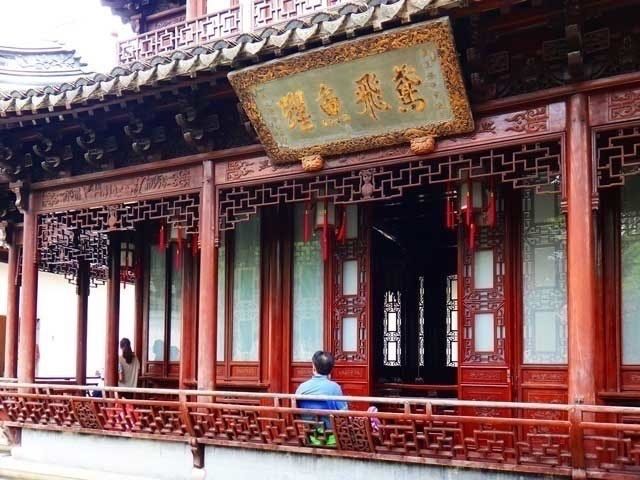
The other point of interest is the outer wall of the building, covered by more than a hundred wooden tablets.

The tablets are engraved with pictures of plants.

Additionally, 40 engravings just below the roof are dedicated to telling a famous love story. The pictures on the Ting Tao Tower told only brief excerpts from famous Chinese stories. The Hanbi Tower, on the other hand, tells the reader the whole of “The Story of the Western Wing” (also translated as “Romance of the West Chamber”), a famous play from the 13th century.

It tells of a man who met a beautiful young woman at a temple. The man fell in love with her, but as her parents guarded her jealously, he could not approach her. Still, he burned with the desire to tell her how much he loved her. Finally, he came up with an idea. At a poetry reading, he read out a poem he had written to the woman he loved. The girl found out how much he loved her, and still they could not meet.
Years passed. Stories of the beauty of the woman traveled far and wide. It was a stroke of misfortune that these stories were also heard by a group of bandits, who decided to lay siege to the woman’s house and to abduct her. The man found out about their plan and went to a friend for help. This friend, a military officer of high rank, agreed to help him, and they successfully defended her house from the attack. Then the girl’s parents agreed to let him court her. Had he not earned his chance to express his love to her face to face?
A Chinese love story with a happy ending.
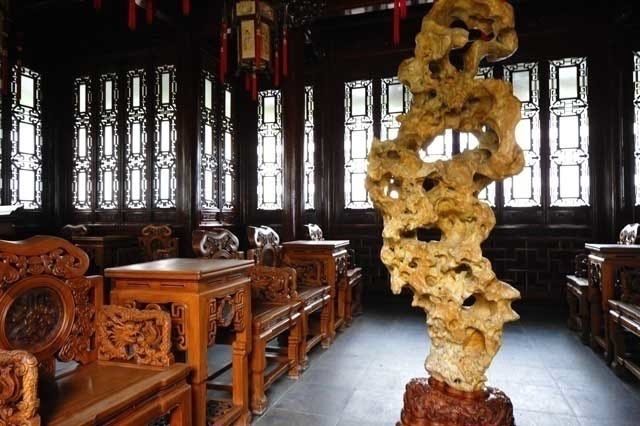
In addition to detailed engravings, the interior of the Hanbi Tower also contains fine examples of the Qing dynasty style furniture.

On the western side of the area, next to the Exquisite Jade Rock, you find a small, secluded courtyard accessible through a small round opening. This courtyard might be closed to tourists but it is nevertheless an important one.
In the southern part of the courtyard there is the Depository of Books and Paintings (No. 29). Again, another building erected to increase the harmony in the garden. As you might recall, the northern section of Yuyuan Garden, the third area, to be precise, held the Relic Hall. The building here was meant for use as a library. Although in English the names of the respective buildings are different, in Chinese, they mean the same thing. Each name reflects the use of the building as a depository for treasures.
One of these buildings is located in the northern end of the garden; the other is located toward the south, near the Yuhua Hall. Irrelevant? No. Again, you might remember that the favorite place for Pan Yunduan to read and study was the Yuhua Hall.

In front of the Depository of Books and Paintings lies a green field. In Yuyuan Garden, every detail, no matter how seemingly unimportant, has a specific and premeditated meaning. So it is also with the five rocks completing the field. The two farthest rocks on either side are actually meant to perfect the view, and to emphasize the importance of the middle three, which symbolize the three immortal sages or star gods of ancient China. On the right stands Fu, or Good Fortune. The middle rock is Lu, or Prosperity. And on the left stands Shou, or Longevity. In Chinese culture they are commonly used to denote the three attributes of a good life, and are collectively worshipped to bring good fortune to a family.

These rocks also have a reputation of bestowing blessings. Longevity can increase your lifespan until you are as immortal as the South Mountain. Good Fortune brings joy into your house until it can fill the Eastern Sea. By the way, in China, the Eastern Sea is the name of the sea located between China and Japan; the name also symbolizes the infinitely large. If you wish to try and court their blessing, take a seat nearby. If you are lucky, perhaps you will be touched by the spirit of good fortune.
On the northern side of the courtyard stands the Deyue Hall (No. 30). In English, the name means the Hall of Watching the Moon. As this activity was very popular, a separate building was constructed here for this purpose. Watching the moon was considered both philosophical and poetic.

The often-quoted Li Bai, who lived in the 8th century, has composed some of his best poems on the topic of the moon.

Let’s cross now the Huanlong Bridge (No. 31) on your way to the sixth area.

It has to be said that the fifth area of Yuyuan Garden is by far the richest. It also offers the most complete insight into Chinese culture. Here, you saw artificial mountains and caves, crafted by masters; you heard old and classical tales; you managed to take a long look at the treasure of the garden, the Exquisite Jade Rock; you saw the furniture used in China of old; perhaps you even tried to chase immortality. Although it might seem, that surely, Yuyuan Garden must be traveled end to end by now, we have to point out that the sixth, and last, area is still unknown to you. Let’s head there.
The sixth area of Yuyuan Garden is in many ways different from the other areas visited earlier. The main reason for that is simple – this area was actually built almost 150 years later, during the Qing dynasty.

In 1709, the City God Temple, then owner of the garden, required a new back yard. What is now the sixth area of Yuyuan Garden was built for that very purpose. In many aspects, this means it stands apart as a garden of its own, and that is apparent in the name of the area as well. Welcome to Neiyuan, or the Inner Garden.
The gate to the Inner Garden (No. 32) stands next to the West Gate of Yuyuan Garden. It’s black, and bears the name Neiyuan in golden lettering.

Pass through the gate, and through another, smaller doorway, and you come to a courtyard.

An artificial mountain dominates the center of the courtyard; on the sides of the mountain are different buildings.
The northernmost building is called the Jingguan Hall, or the Hall of Enjoying Tranquil Stone Animals (No. 33), and it is the most important building in the Inner Garden.

It could be said that the Jingguan Hall was built for one purpose only – to offer a place where people could enjoy silence and the beauty of this artificial mountain. And even though this part of Yuyuan Garden was not built, nor planned, by Pan Yunduan, the Qing dynasty craftsmen went to great lengths to maintain the Daoist style used by Pan Yunduan.
Here, like elsewhere in the garden, the focus lies on the beauty and inner silence of nature. The name of the hall in Chinese makes a reference to a line from a Tang dynasty poem: “The heart looks toward the silence at the center.” In this case, the central silence is represented by the imposing artificial mountain located in front of the hall.
The mountain is rather colorful, some trees on it are over 200 years old. Its stones come in different shapes and sizes; from their midst, trees reach toward the sky.

Although the mountain lacks a name of its own, it contains stones that do have names. You can see the stones named Nine Lions Playing a Ball, Peacock Spreading Its Beautiful Tail, and Rhinoceros Looking at the Moon.

There are also stones resembling tigers, monkeys, goats, sheep, and turtles. And this resemblance is not random – according to Chinese traditions, all these animals bring people good luck. In the fifth area, you perhaps asked for long life or good fortune; here, you can ask for your other wishes to be fulfilled or your undertakings to succeed.
On the western side of the artificial mountain stands the highest building in Yuyuan Garden – the three-story Guantao Tower or the Tower for Enjoying Huangpu Waves (No. 34). During the 18th century, when it was built, it was the highest building in all Shanghai! It is due to the fact that this tower was constructed many years later than other buildings in the garden. And during those years the buildings surrounding the garden had also become higher. So, it was necessary to build it so high to be able to see over the Huangpu River. A lot of time has passed since then, today even a 30-story tower wouldn’t show you the waves on the Huangpu River.
The sixth area also holds the southernmost point of Yuyuan Garden – a classical Chinese theater, called the Ancient Stage (No. 35). The stage was built in 1888 but brought here in 1974 and opened for performances in 1988. It is considered to be the number one theater stage in China south of the Yangtze River. Every year, there are performances of classical Chinese music, huju or the Shanghai opera, and kunqu or the Kunqu opera.
Kunqu opera is a variation of Chinese opera, and while it may be seen in both North and South China, it is mostly a performance characteristic of Shanghai.

The upper part of the stage is covered with decorations. The two stone columns flanking the stage are inscribed with golden Chinese characters. The words were uttered by Yu Zhengfei, a famous Kunqu opera star. The writing on the right means: “People live as long as the sky.” The writing on the left translates as: “Clouds wear clothes like flowers wear their blossoms.” As you can see, the wishes for longevity are present here as well. Actually, in China it’s highly common to exchange pleasantries in the form of wishes for long life, and it is an important way of expressing respect for the elderly.

Let’s step closer, under the eaves you see two golden dragons playing with a ball. You met those same dragons at the gate between the third and fourth areas. Above the dragons are pictures of classical Chinese stories.

On the sides of the Ancient Stage run the Eastern Corridor and the Western Corridor, filled with seats for more than 200 people. The furniture is, again, in the Ming dynasty style.
Across the courtyard from the Ancient Stage stands the Dress Circle (No. 36). In times past, the most prominent visitors watched the shows from here.
Next, let’s visit another artificial mountain. Here, you find the Stone Boat (No. 37). As with the boathouse you saw in the second area, this one is also built to resemble a boat. The main difference between the two boathouses is that the landscape in front of the Stone Boat is designed to resemble waves.
Descending from the top of the mountain and taking the narrow staircase toward the east, you come across several stone tablets (No. 38) mounted on the outer wall of Yuyuan Garden. You might recall that the Sansui Hall near the main entrance contained the white stone tablet with inscriptions, written by Pan Yunduan himself, telling the story of how the garden was built. The tablets here tell the story of how the Inner Garden was built. As said before, history is very important in China, and in a way, writing down the history of a place ensures that the soul of the place lives on for a long time.

Since the Inner Garden was built later than the rest of Yuyuan Garden, it was deemed necessary to have its particular story told as well, here on these tablets.
And finally, there are only two more sites to see. The first is the Nine Dragon Pond (No. 39), or as it’s called in Chinese, Jiu Long Chi. The way there goes over narrow paths that slowly turn into corridors. It is easy to get lost here, but don’t worry, the nine dragons located nearby will help to keep you on the right track.
The Nine Dragon Pond with its small waterfall is a beautiful sight.

The name of the pond is actually connected to the fourth area – there you saw the Nine Lion Pond. Again, this represents an effort to create balance in the garden. The lion and the dragon, by the way, are the most common animals in both Chinese architecture and mythology.
Close to the Nine Dragon Pond you find one more dragon, called the Sleeping Dragon, or Shuimian Long (No. 40). It has hidden itself on a wall between the pavilions and narrow pathways on the artificial mountain.

This concludes your wondrous marathon through Yuyuan Garden. Looking back, it seems you’ve learned many things about Chinese culture and history. And considering the Daoist principles at work in the garden, surely something of that mindset stuck to you as well.
Don’t be surprised, then, if the first minutes after leaving the garden through the West Gate of Yuyuan Garden (No. 41) and entering the boiling cauldron of humanity known as Shanghai you feel strangely out of place. Indeed, once Yuyuan Garden is behind you, it will seem like a dream, a refreshing drink in this urban desert.
Although today Yuyuan Garden is a glittering pearl in the middle of Shanghai, the history of the garden is much darker and filled with tragedies, pain, and misery.

The history of Yuyuan Garden reaches back 400 years, to the Ming dynasty. During that time, there lived a highly educated and well respected official by the name of Pan Yunduan (1526-1610). He wished to build a garden so that his father, Pan En, might spend his old age in peace and comfort.

To you, this might seem weird. In Confucian China, however, this was, and still is, perfectly normal. In China, taking care of your parents is the most noble thing of all. In the spirit of Confucian teachings, in 1559, Pan Yunduan set out to build a spectacular garden to serve as a trouble-free home for his father in his old age. The garden was named Yuyuan. Yuan in Chinese means garden, and yu means pleasing and satisfying, or without troubles.
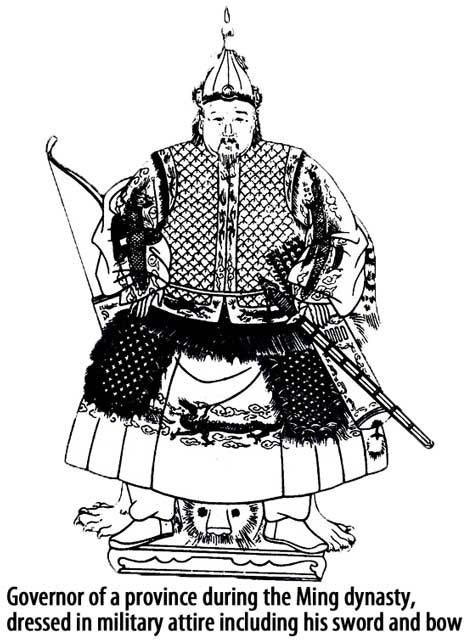
The tragedy of the story lies in the fact that Pan Yunduan did not have the time to keep building the garden, as he worked as the governor of Sichuan in western China, some 1,100 kilometers (680 miles) west of Shanghai. And before the garden was completed, Pan En died. By that time, Pan Yunduan had spent 23 years building the garden, yet it was incomplete. The building was only sped up when Pan Yunduan retired in 1577. When Pan Yunduan retired, his father was still alive, but a project of this magnitude could not be completed in the time left to them. After all, Pan Yunduan was not a courtier in the imperial court, where money was no issue.
Yuyuan Garden was completed at the end of the 16th century, a bit before Pan Yunduan himself died in 1610. Luckily, he had some time to enjoy the garden in its full glory. In his old age, he spent his days in Yuyuan Garden, surrounded by books and paintings.
With Pan Yunduan’s death, the heyday of the garden came to an end as well. In the context of the time, Yuyuan Garden was an exceptionally large private garden, and it was very expensive to maintain. Although the Pan family was wealthy, a few years after the death of Pan Yunduan, the garden proved too much for their wallets and Yuyuan Garden entered a slow decline. By the darkest hour, there was not much left of the garden. It was being sold off, piece by piece. The remaining buildings became the property of the Qing dynasty.

Salvation came in the form of the Qianlong Emperor of the Qing dynasty. He announced a fundraising to buy back all the pieces of the former Yuyuan Garden. By 1784, the garden was again in one piece and restored to its former glory. As the garden lacked an owner, the emperor decreed that the garden would be under the authority of the City God Temple, located nearby. Yuyuan Garden became Xiyuan, or the Western Garden, as it was located west of the temple, and was restored to its former glory and magnificence.

Sadly, these good times only lasted for 50 years. From the middle of the 19th century, China was subject to various uprisings, insurrections, and invasions, each leaving their marks.

And so, the bad times began again with the First Opium War from 1839 to 1842, when British troops invaded Shanghai and turned Yuyuan Garden into a military encampment.

The second wave of horrors came 10 years later, when China was suffering under the Taiping Rebellion from 1850 to 1864. Yuyuan Garden was conquered by the Small Swords Society, the buildings here were converted to warehouses or command centers. As the troops loyal to the Qing dynasty launched their counterattack, Yuyuan Garden became a battlefield and was almost leveled.
However, this was not the final act. A few years later, when the Taiping Rebellion was still in full force, the armies of France and the British Empire allied with the Qing dynasty forces in order to keep the Taiping out of Shanghai. The remaining buildings of the garden were again turned to military use. When the rebellion was finally quelled, Yuyuan Garden was divided between several small enterprises. The once harmonious garden became an entertainment district, complete with teahouses, hotels, markets, and bars.

And then, in 1937, when Japan began its offensive to capture Shanghai, Yuyuan Garden was overrun by huge numbers of refugees. This marked the next end of Yuyuan Garden.

It’s remarkable that after all this, Yuyuan Garden still rose from its ashes! This time after the foundation of the People’s Republic of China. In 1956, extensive renovations were started, but as late as 2003 the work was still not complete. This illustrates how grievously the garden was damaged, and also how thorough the rebuilding effort was.

Today, Yuyuan Garden represents an excellent cross-section of the treasures of Chinese culture. Because of this, pages and pages can be written about nearly every corner, building, or bridge in the garden. The creator of Yuyuan Garden, Pan Yunduan, sought to build perfection; considering the amount of stories one can tell about the garden, he quite possibly succeeded!
This concludes our story of one of the most lavish and celebrated gardens in China, which was built simply for an opportunity to give a man’s father a place to spend his old age. What a stellar example of Confucian morals!

4. Corridor for Approaching the Best Scenery
29. Depository of Books and Paintings
Chinese Traditions and Customs
China’s long history as a single nation has given rise to some very specific traditions and customs that link to everyday life.

Chinese culture is very different from Western culture. In the West the individual is at the heart of his/her own world. It’s said that this stems from Ancient Greece where the tradition of debating and personal representation influenced the development of all the Western World. Whereas in China the individual is not the center of the culture – society is.
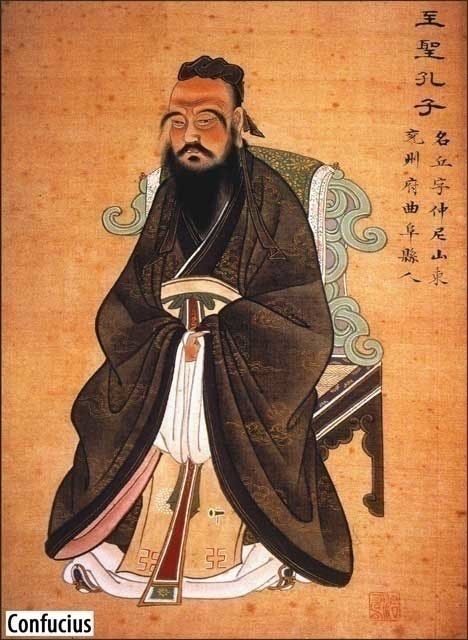
This began with Confucius who lived in the 5th century B.C.E. His teachings developed the structure of Chinese life and the hierarchy that still to a great extent governs every relationship in China today.
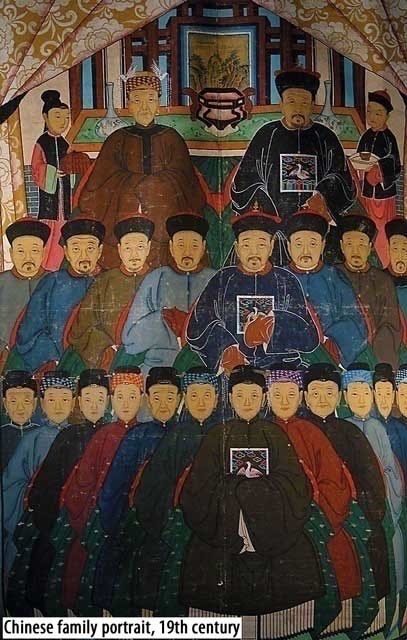
In that structure the essential unit of Chinese society is the family. This has meant that traditionally multiple generations of the same family would work together, live together and be together wherever possible. In modern China, however, this tends not to be the case in practice anymore. That’s because of the need to travel to find work. Previously someone’s hometown was their identity and they would remain in the place they were born until they died, travelers were an exception rather than a rule.
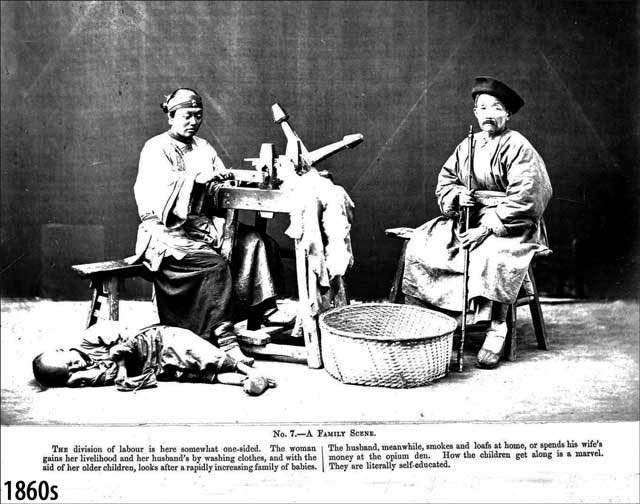
Families in China have always been patrilineal, meaning that the family line runs through the male of the family. When someone enters the family through birth or marriage it is always the man’s family they join.

There is a great emphasis on the respect for elders and in general terms the oldest members of a family will make the family’s decisions and the rest of the family will carry out those decisions.

You may have heard it said that Chinese people have no religion but this is not true. The traditional Chinese beliefs really amount to a form of ancestor worship and there is a lot of pressure within the family unit to honor those who have passed on and in particular men who have died. It is believed to be bad luck if the family fails in this obligation. It’s also believed that male members of a family who fail to produce a mail heir will become a volatile ghost after they die.

In the West we divide our families into simple titles; brother, sister, uncle, and so on, because there is no special place in the family hierarchy accorded to someone’s rank. In China each of the positions in a family is carefully divided to enable someone to work out their place in the pecking order. Thus, an older brother will have a different title to a younger one. Somewhere within this there is also an acknowledgement that Chinese family units have traditionally been very large and it’s important for everyone to determine where they sit within the family at family gatherings.
Much of this is changing in modern China. Women are getting more say in the running of the family and children are beginning to gain control of their own futures. Though, how much modernity is found in any family varies very much. In Beijing the modern family makes up the sizeable majority of the population, in rural areas the reverse is true. It’s worth noting that these changes are recent and often fragile. Most Chinese people wouldn’t dream of just setting out on their own to do something even if they know that is what they will eventually do. They will almost always consult their families before making any major decision and the family’s approval is very important to them.
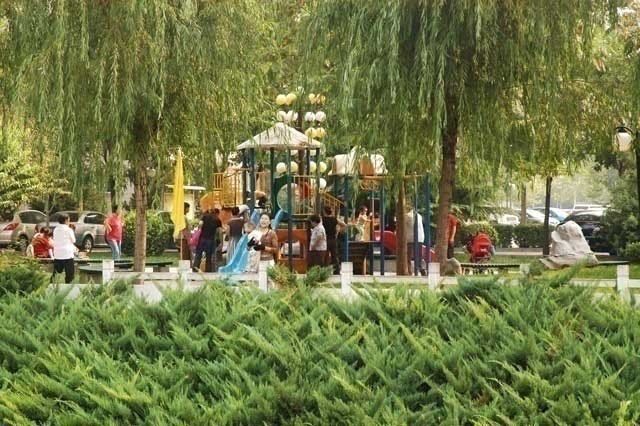

To aid conception, dolls and lotus seeds may be left on the marital bed to increase fertility. Eating tofu, lettuce and mushrooms is said to improve the chances of having a boy and eating meat and fish the chances of a girl.
There are many prenatal beliefs that the Chinese follow to ensure the healthy birth of a child. Furniture must not be rearranged or feng shui might damage the child. The mother’s belly should not be rubbed. Women may not work with glue as it makes, according to common belief, the birth complicated. Women’s round bellies means girl babies. A woman must not eat sour foods because it might make them miscarry. The most virtuous babies are those who are born to softly spoken women who walk without swinging their arms.
There are other customs to be followed during the birth. The father is expected to stay away from the birth of the first child but is welcome to join the birth of other children. The pregnant lady’s mother should be there for the first child’s birth. Tea should be drunk during labor to reduce pain. No cold drinks should be taken in order to ensure the baby’s qi (that’s the life force). Squid should not be eaten because it is believed to make the process sticky.
Finally, following the birth there is supposed to be a one-month recovery period (called zuoy uezi) in which the mother stays in bed to rest. She’s supposed to eat lots of chicken, rice, fish with ginger and a lot of pig knuckle soup to replace the nutrients lost during birth. She should not eat salt, as it is believed it interferes with the ability to produce milk. She’s not supposed to take a bath or a shower during the month. A sponge bath might be acceptable. Hair must not be washed to avoid headaches. The umbilical cord will be wrapped in red paper and held in the house, and it must be kept safe because if it is eaten by a rat the baby will sicken.
The first month of life of the baby, or muen yuet, is celebrated. There are no special food or rituals, but family and friends will bring red envelopes with money. And the woman may finally have a wash.

As you can imagine, this set of customs is changing quickly in modern China, as it’s simply not practical for a career woman to spend an entire month in bed.
You should note that a baby with more than one circle of hair is supposed to grow up to be a bit of a rascal. One with thick and wide ears is supposedly going to be rich. You should also never say anything complimentary about someone’s baby, as the Chinese believe this might cause jealousy of the child and in return the baby might suffer ill-health.

The one child policy has, for decades, restricted urban couples (this hasn’t applied to rural areas) to a single child. In China, given the cultural significance of having a boy, this has led to a rather new and unpleasant tradition of aborting fetuses of the female sex. There are serious issues connected with this, leading to many millions more men of marriageable age than women.

Dating is another area that is changing rapidly in modern China and many traditions are being quickly discarded by well-educated offspring who have been lucky enough to head to the big city. Nonetheless there is a substantial part of the Chinese population who still adhere strictly to tradition too.

In some parts of the country marriages might not involve a whole lot of dating at all as parents may just arrange them. However, in general Chinese marriages are love marriages. The first thing a young couple must consider is their family and that means they wish to ensure their dating is respectable and does not bring dishonor to the woman.
The man traditionally makes the first move. While Chinese girls are not shy about making their intentions clear it is still expected for the man to ask the woman out on the first date. A man who fails in this obligation may be left flirting forever, as it would be very unusual for a girl to do the asking.
The first date can be a bit of a nightmare from a Western perspective. No self-respecting Chinese girl is coming to that date on her own. That means that he will need to book a large table so that her friends can come too and start working out if he’s a good match for her. The date is something like an interview and her friends will not so discretely squeeze all the relevant information out of the young man. That includes salary, prospects, education history, ambitions, and so on and on.

It’s perfectly acceptable for either party to terminate the relationship following the first date and there’s very little in the way of hurt feelings if this is done.
The second date tends to be a more intimate one, though the young lady may remain accompanied by a single companion all the way up to marriage.
Sex is not a big part of Chinese dating traditionally. Women who are not virgins are considered soiled and much less desirable by Chinese men. Or at least that’s what Westerners who are unfamiliar with Chinese culture are told. The truth is a little more vague. The Chinese have a culture of headstrong romance and by the end of the second date most girls will have decided if he’s “the one” or not. The Chinese tend to rush into romance rather than spend time working each other out before committing. One of the easiest ways for a Chinese girl to ensure that he stays committed is to go to bed with him. He will then be expected to marry her. Unlike in the West, the Chinese demand faithfulness throughout the dating phase (from the second date onwards) so there’s little risk in a Chinese girl following this strategy.
Unfortunately, this is where many visitors to China get it wrong. They work from their cultural morals rather than Chinese ones and find themselves in hot water when they realize their one night stand has been seen as a marriage proposal.
Once the couple are reasonably certain of their intentions they will approach their parents for their blessing. This is much more of an obstacle than it is in the West. Parents want the best for their children and once again assess the partner on their prospects of adding value to their family. This assessment may take several months and each time they visit the prospect bride’s parents, the man has to take a gift to show his respect.
If they are lucky and both sides are pleased with their prospective in-laws then they move on to marriage proper.

There is nothing less romantic than an official Chinese wedding ceremony. There are no guests, no ceremonies, and no parties. Instead, the couple take their national ID cards to a registry office where they will sit in a queue with a lot of other couples. When they get to the front they pay to have their photo taken, fill in an application form, and as long as their documents are in order, are then announced to be married by the official, and given a marriage booklet each, like a little passport book. That’s it.
The Chinese have no custom of going to a temple or church. Wedding rings are a new tradition, there were no wedding rings in ancient China. Furthermore, wedding rings are not usually worn after the ceremony itself. Instead, the doors of the new couple’s home are marked with the red xi character – the symbol of good luck that means “double happiness” – for up to a year to ensure eternal happiness.

However, that doesn’t mean that marriage itself is not romantic. After the official marriage, usually sometime in the next six months or so, the couple will often recreate a marriage ceremony so that they may have photos taken.

They will dress up in a multitude of costumes and change locations several times so that they may share the image of a dream wedding with their friends and family.

They will also have a celebration meal at some point during the same period. Friends and family are invited.

There will be a feast and plenty of drinking. And there are often party games, such as endless ganbei – toasting, plus sexually suggestive games. For example, the husband will place a balloon between his legs and her job will be to pull it out with her teeth, in front of the whole crowd, without bursting it.
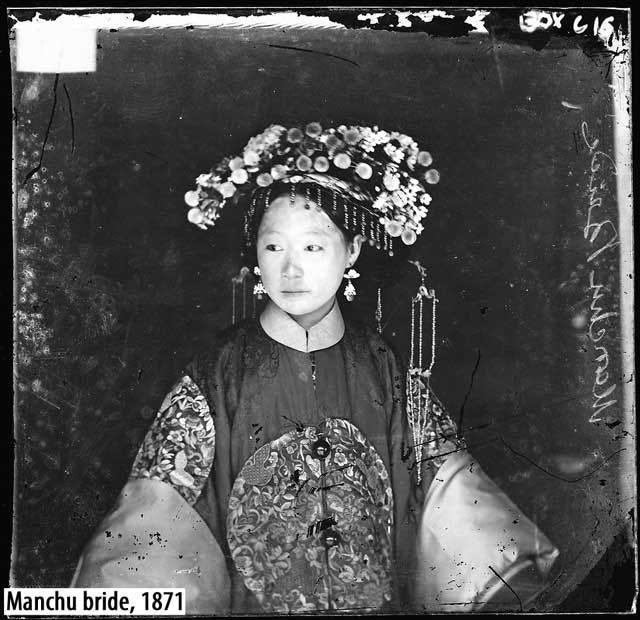
Chinese marriage traditions date back to the 4th century B.C.E. when the Chinese marriage was standardized. Despite China’s long history and many different geographical areas, there were essentially six rituals, generally known as the “three letters and six etiquettes.”

Three letters included the Betrothal Letter, Gift Letter, and Wedding Letter. The Betrothal Letter was the legal document of the engagement. The Gift Letter listed gifts for the wedding and was sent to the bride’s family. The Wedding Letter was the document prepared and presented to the bride’s family on the day of the wedding to confirm the formal acceptance of the bride into the groom’s family.
The first of the six etiquettes was proposing: if the boy’s parents approved the girl as their future daughter-in-law, they had to find a matchmaker. The matchmaker presented his or her client’s request to the parents of the bride-to-be.
Proposing was followed by birthday matching: if the bride’s parents accepted the proposal, the matchmaker asked for the bride’s birthdate. If, according to suan ming or Chinese fortune telling, the couple’s birthdays and birth hours were matching, the marriage preparations would continue. In case of any signs that the marriage would bring disaster to the couple’s families the wedding would not take place.
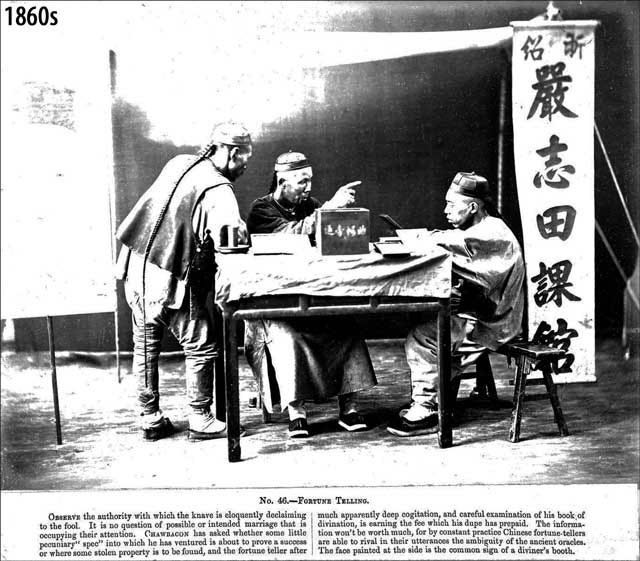
The third etiquette included presenting betrothal gifts: now was the time for the matchmaker to present the Betrothal Letter and betrothal gifts to the bride’s family.

Then, as the fourth etiquette, the groom’s family would send wedding gifts to the bride’s family, consisting of an elaborate array of food, cakes, and religious items. Usually, gifts included tea, lotus seeds, red beans, green beans, red dates, oranges, lily, pomegranate, bridal cakes, coconuts, wine, a money box, and other items, depending on the local customs and the wealth of the family.
Picking a wedding date was the next thing to do. This was done by consulting Tung Shing (literally All-knowing Book), which is a Chinese divination guide and almanac, consisting primarily of a calendar based on the Chinese lunar year. Selecting an auspicious day to assure a good future for the couple was as important as avoiding what was believed to be an unlucky day.
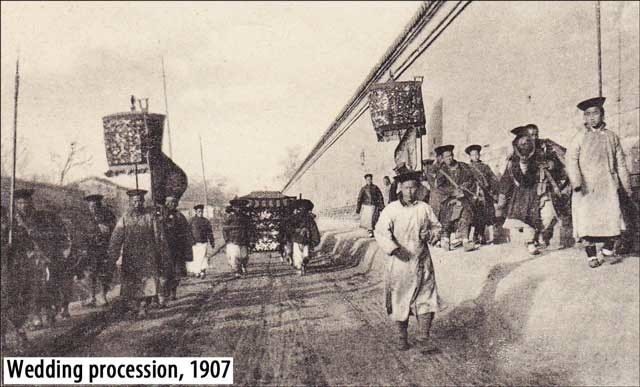
And finally, the sixth etiquette – the long expected spectacular wedding ceremony itself.
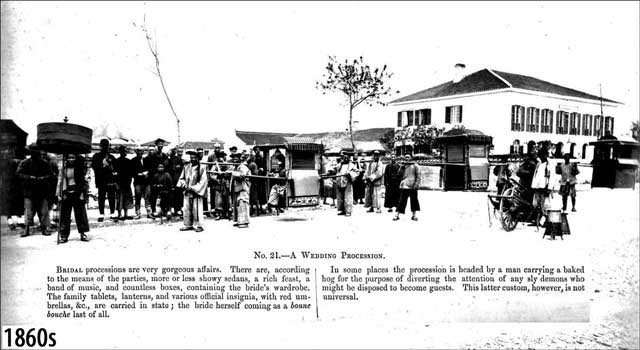
In ancient China, it was customary for the groom to travel to the home of the father of the bride to pick up his future wife. From there, the couple traveled to the home of the groom, where the official wedding ceremony was held. Afterwards, the bride would live in the groom’s home, and the bride usually brought along all necessities for a shared life: cutlery and silverware, household items and if possible, even furniture.

Many old wedding traditions still survive in China. For example, grooms travel to their brides’ home and participate in various rituals.
A tea drinking ceremony is a given, and the groom addresses the bride’s parents as mother and father for the first time.

During the traditional marriage ceremony the bride and groom kneel on the ground in front of their parents and then pour tea for them. This is to express their gratitude for their upbringing.
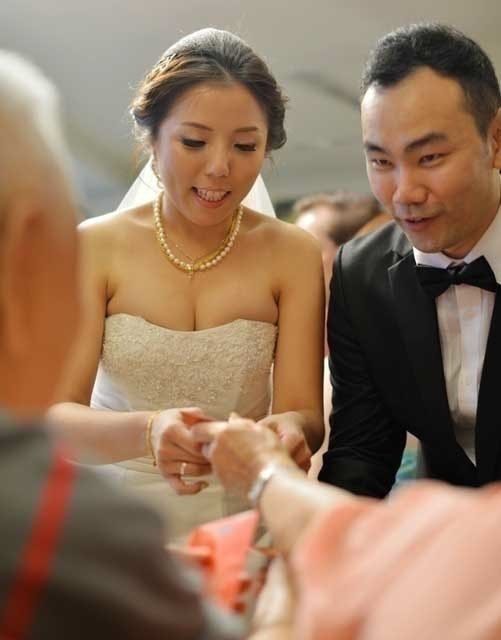
Once the parents have drunk a little tea, it’s customary for them to give cash gifts in red envelopes or hong bao to the couple.

Sometimes it is only the bride who pours tea for the groom’s family to show she is grateful for the chance to become a part of their family. In China it’s considered that women are joining a new family but that men remain part of their current family when they marry.
It is also quite common for large families at weddings to separate into groups and serve each other tea as a bonding ritual designed to bring the two families closer together.

Guests are also expected to bring cash rather than gifts in the form of hong bao – a red envelope that’s supposed to be lucky.
In China, wedding ceremonies have always included a symbolic meal of dumplings. The parents of the bride would prepare the dumplings but leave them semi-cooked. These dumplings would then be offered to the bride, who would reply, “these are raw” or “sheng” in Chinese. As sheng also means “to give birth” it is a way for the bride to announce her readiness to bear children.
Traditionally, the couple would also partake of longevity noodles, a special dish to ensure long life, and drink Chinese rice wine out of a double-sided chalice, ensuring a long and happy life of sharing.

Once the marriage would have been expected to be consummated after the wedding party, meaning that the couple would have had sex the first time, making the marriage legally binding. But in today’s China it would be very unusual for the couple to wait until this event before they made love.

Chinese people need to be 21 years old to get married, and child brides are relatively unheard of except in some rural locations where arranged marriages may leave a girl virtually married from the age of sexual maturity (this is currently set at 14 by the law).

It is not unheard of, though the practice is dying out, for a man to pay the bride’s family a bride price on the day they are married. This is often a reasonably large sum by Chinese standards.

In China, marriage has been traditionally considered to be for life. Even during the early period of communist rule, divorce was nearly unheard of. However, life is changing quickly in China now and the divorce rate is spiraling upwards.
In traditional Chinese society, there were three major ways to dissolve a marriage. The first one was no-fault divorce. According to the legal code of the Tang dynasty (618-907), a marriage could be dissolved due to personal incompatibility, provided that the husband writes a divorce note.
The second way was through state-mandated annulment of marriage. This applied when one spouse committed a serious crime against the other or his or her clan.
And then, the husband could unilaterally declare a divorce. To be legally recognized, it must have been based on one of the seven reasons. First, if the wife lacked filial piety toward her parents-in-law. This made the parents-in-law potentially capable of breaking a marriage against both partners’ wills. Or second, she failed to bear a son. Then, if she was vulgar or adulterous. If she was jealous – this included objecting to her husband taking an additional wife or concubine. If she had a bad disease. If she was gossipy. And finally, if she committed theft.
Obviously, these reasons could be manipulated quite a bit to favor the husband and his family. There were, however, three clearly defined exceptions under which unilateral divorce was forbidden despite the presence of any of these seven grounds: when she had no family to return to; when she had observed a full, three-year mourning for a parent-in-law; when her husband was poor when they married and was now rich.

Following marriage the bride will become part of the groom’s family. She is then supposed to devote her energies to him, his parents and any children they have. In practice, this is also dying out and women want to retain strong relations and even send money back to their own parents.
Many wedding traditions have survived almost unchanged from the distant past, whereas new ones have also been borrowed, as is often the case with modern life.

The imperial wedding, of course, was an altogether different affair. It could be truly grand, as, for example, the wedding of the Guangxu Emperor and Empress Longyu in 1889.
The Guangxu Emperor, who was crowned at the age of four, had never really gotten to lead the country. This was all done by his aunt, the Empress Dowager Cixi.

The wedding of the Guangxu Emperor was also organized by Cixi, and with equal skill; love, unfortunately, had nothing to do with the entire thing. Cixi was only looking to guarantee her power. Thus, the then 19 year old Guangxu Emperor married Longyu, a niece of Cixi’s.
Weddings were always preceded by selecting the spouse. Traditions dictated that the emperor be presented with a number of concubines, from whom he would pick his future empress. When the emperor had made his choice, he would present his chosen one with a ruyi, the ceremonial scepter.

Ruyi means “as you wish” and a ruyi scepter is a talisman presented to bestow good fortune on various occasions. It is composed of a long handle and a head which is usually in the form of a heart, a cloud, or a longevity fungus.
The Guangxu Emperor had to choose from among five women.

One of them was his favorite concubine, Imperial Consort Zhen.
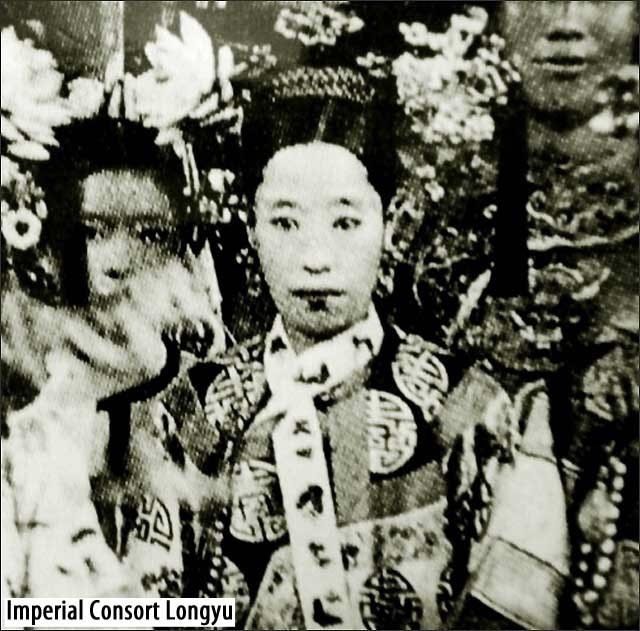
Unfortunately, the emperor could not pick her, and under the watchful eye of Empress Dowager Cixi presented his ruyi to Longyu.
After the emperor had announced his choice, the future empress had to leave the Forbidden City and live in his father’s home until the wedding. Usually the wedding took place months later, after the father of the bride had hosted a party for all relatives. The emperor did not seek to avoid his responsibilities regarding these parties and provided much help, both in the form of produce, but also in the form of luxurious gifts sent to the family of the bride. Gold, silver, silk, and horses were just some of the articles that have been historically given. Gifts from relatives of the bride, on the other hand, were usually household goods.
Longyu’s family also hosted a great party for their relatives. It was likely the first and last time most visitors would see such an event and they returned the courtesy shown them by courteous bows toward the Forbidden City to thank the emperor for the magnificent reception.
It was customary for the groom to travel to the home of the father of the bride to pick up his future wife. From there, the couple traveled to the home of the groom, where the official wedding ceremony was held. According to this tradition, the emperor was also to pick up Longyu. Given that the groom was the emperor, however, the travel and pick up was handled by his emissaries. As their first task, they presented the future empress with her official title and name, her birth name Yehenara would be changed to Empress Longyu. She was also presented with a golden seal to be used when signing formal letters and documents. The seal was adorned with script in both Chinese and Manchu characters, proclaiming it to be the Seal of the Empress. Naturally, the seal could only be used by the empress herself.
The empress would then put on the ceremonial robes, adorned with images of phoenixes, and travel to the Forbidden City in a sedan chair, surrounded by the wedding party.

Her servants would carry her through the central entrance of the Meridian Gate – the main entrance to the Forbidden City. This was the only time when the empress could enter the Forbidden City through the entrance normally reserved for the emperor.

The first symbolic act performed by the empress was presenting the emperor with an apple. This indicated wishes for a happy and peaceful marriage. The emperor responded with a gift of a bottle, filled with jewels, gold, and silver. This symbolized the national treasury, which was now in shared hands.

The empress also had to step over a saddle placed on the ground above two apples – another gesture meant to ensure happiness. Then the empress had to jump over a bonfire to break free from obstacles and evil spirits, who could otherwise threaten their future life. As an alternative, evil spirits could also be driven off by a display of archery. This required the emperor to shoot three arrows over the empress’s head, which was definitely a more dangerous approach. It only needed a twitch of the hand to prove fatal.
According to Manchu wedding traditions, the Guangxu Emperor had to reveal the face of the empress. For this, the empress would be wearing a red scarf that hid her face.

The wedding rituals of the Guangxu Emperor and Empress Longyu were mainly held at the Palace of Earthly Tranquility. The wedding ceremony was held in the main hall, and afterward the emperor and empress retired to the two halls that constituted an imperial bridal suite where they spent a few days and nights together before moving into their own separate residences.
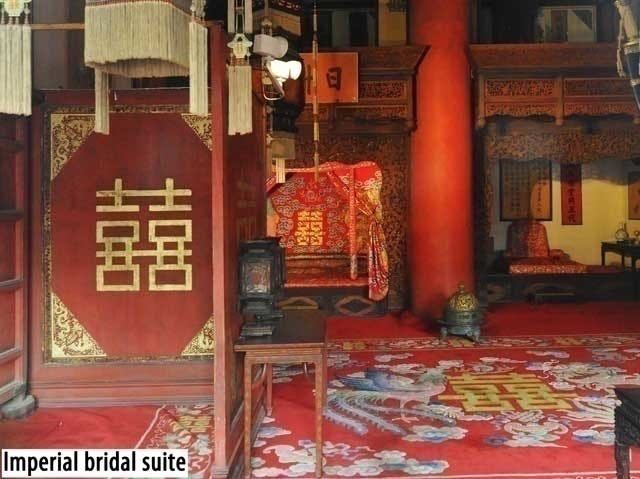
The main color of the Imperial Bridal Suite is red. The reason for this is simple – in China, red is the color of happiness. In addition to the red, the room contains other symbols of happiness – the golden xi character, dragons and phoenixes, bats, peach tree branches, pumpkin vines, etc. Peaches are supposed to grant robust health and longevity; pumpkins symbolize male children, which was, of course, essential for any emperor wishing to continue the dynasty. Together, all these symbols were said to ensure a long, happy, and fruitful marriage. And if other good luck omens – plants, birds, animals – could also be seen elsewhere, the xi character was exclusively reserved for weddings. Here, it is on tables, chairs, carpets, and walls.
There were two magnificent banquets held as part of the wedding ceremony. One was held by the Guangxu Emperor for the male relatives of the empress and to the male servants and officials of the Forbidden City. The other was held by the empress for her female relatives and female servants of the Forbidden City.
After the ceremony ended, officials announced the marriage of the emperor and the empress from the balcony of Tiananmen Gate, or the Gate of Heavenly Peace, to the rest of Beijing.

One of the happiest royal marriages in the Chinese history took place between the Qianlong Emperor and Empress Xiaoxianchun.

Qianlong, then called Hongli, and Prince Bao of the First Rank, and the empress-to-be Xiaoxianchun, then called Lady Fuca, married in 1727 when she was 15 years old, and she was granted the title of Primary Consort. In 1735 the Yongzheng Emperor died and was succeeded by Hongli, who became the Qianlong Emperor. Two years later, in 1737, Qianlong instated Lady Fuca as his empress by the name of Xiaoxianchun.
The emperor and the whole nation of China loved her deeply. Empress Xiaoxianchun was a gentle, loving and virtuous woman. She took good care of her husband and treated fairly all the concubines, eunuchs, and servant maids. The empress didn’t care too much for expensive jewelry, instead she would wear wildflowers in her hair.

Qianlong loved his wife so much that he didn’t want to spend even one day without her company. Thus, it was natural that Xiaoxianchun accompanied the emperor on his long trips. Unfortunately, during one of these journeys Xiaoxianchun fell seriously ill and died at the age of 36.

The heartbroken emperor found comfort only by her grave in the Yuling Mausoleum in the Eastern Qing Tombs – a spot he visited quite often.
But not all the royal marriages were surrounded by the aura of a fairy tale. The wedding of China’s last emperor, Puyi, took place in 1922. He had picked himself a beautiful young bride, Wanrong.

The wedding preparations cost a lot of money. The Forbidden City was designed with magnificent decorations for the occasion. Four street lamps and a decorated archway were erected at one of the gates to welcome the empress-to-be carried in a royal sedan chair. Everyone thought that Puyi and his lovely wife would be happily married.
And then the wedding night arrived. Puyi stepped into the bedroom where his wife was waiting for him. Suddenly he abandoned Wanrong in the bridal chamber and went back to his own room. He claimed that she was willing to be a wife in name only, in order to carry the title of empress. Soon, Puyi stopped speaking to her and ignored her presence.
Puyi, during his life, was married to five women, but had no children.
The system of empresses, consorts, and concubines often confuses people. Indeed, it is a complicated situation with many different titles being used to describe them, and as the rules and customs changed over the centuries.

The system became most formalized during the Qing dynasty from the 17th century, with a strict hierarchy in place dictating much of the responsibilities and life of these women.

The emperor would take a series of wives, with only the most important being given the title of empress.

The empress would be in charge of all the concubines, grouped below her into seven different levels.

Immediately below the empress in the hierarchy was the second wife known as the Imperial Noble Consort. In day-to-day terms she would be in charge of the household of women. Below her came two Noble Consorts and then four Consorts.

Below these levels came the much less formalized ranks of concubines. They would be headed by six Imperial Concubines, but below them the total number of women would vary greatly in number. They were still split into three different hierarchical levels, known as: Noble Ladies, First Class Attendants, and Second Class Attendants.

Estimates vary as to exactly how many consorts the emperors had in total. During the Ming dynasty (1368-1644) it could have been several hundred, but it is believed things were more restrained in the Qing dynasty (1644-1912).

It is recorded that the Kangxi Emperor took the most consorts during the Qing dynasty – a total of 79 women, including the empress, consorts, and concubines.

The Guangxu Emperor holds the record for having the least consorts.

He had an empress and two consorts, so a total of just three women.

The keeping of such an extensive harem of women was conveniently justified at the time, as the emperors were followers of Daoism.

According to Daoist theory, the emperor was the extreme representation of yang. With women being the representation of yin it was necessary for such a dominant emperor to partner with as many women as possible to ensure harmony in the universe!

The emperor himself controlled the movement between the levels of concubines and consorts, offering promotion to those he favored more, and certainly to those who bore him sons.
With a higher rank came better benefits. Rank strictly determined the financial stipend that the woman would receive, accommodation they would be entitled to, and even how many dishes they ate at mealtimes.

It would be clear to all in the Forbidden City which women belonged to which rank as each level would dress differently, with changing colors, styles, and permitted accessories.
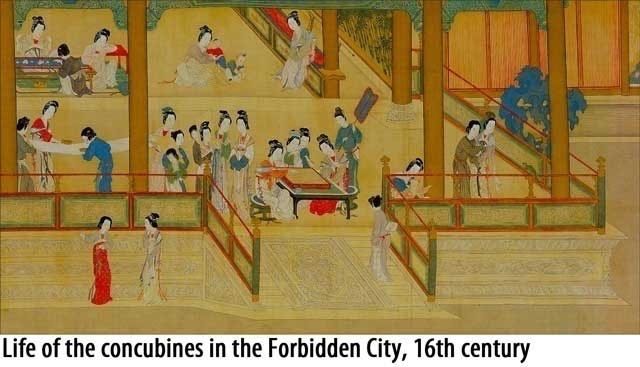
It was considered quite an honor to be chosen as an imperial concubine. During the Ming dynasty girls from all walks of life were considered. The Manchu rulers of the Qing dynasty though preferred to select from their own race and allowed only girls of Manchu origin to be considered.

Recruitment would take place once every three years, with girls attending a selection at the Forbidden City, where officials would consider each on the basis of their appearance, birth background, and important qualities such as benevolence, gentleness, discretion, and loyalty to her family. Success was certainly about more than physical beauty; there was a phrase that was in popular use during the Qing dynasty that said, “Beautiful women ruin the country.”
There were many cases where concubines were introduced in other ways. Sometimes for example girls from important families in other regions or tribes would be introduced to help ease relationships.

Life in the palace for the concubines was generally good, although there were strong differences in treatment depending on the emperor in power and his preferred women.
There are several stories and accounts which describe it as a lonely life. Competition amongst concubines for promotion to higher levels, and to spend time with the emperor, was fierce. And, of course, they were forbidden to form any other relationships. Many became close friends though with the eunuchs also living in the palace and serving the court. Such relationships were accepted as there was no chance the castrated men could threaten the emperor’s family line.

Time with the emperor was very important, and this was dictated to the concubines. It was a combination of the will and preference of the emperor and predictions by astrologers for the most auspicious times to be together. In theory, any of the concubines could become the mother of the next emperor.
The main desire of all imperial consorts was to bear a son for the emperor. This helped the consort rise to a better place in the palace hierarchy. Infighting over the desire to bear sons was often ruthless. There were attempts to end the pregnancy of rival consorts, and to kill already born sons. In this, the consorts were often aided by eunuchs. Those who succeeded in bearing a son could become the mother to a future emperor, and that meant great power and influence.
History knows several infamous consorts who led many to their deaths. Lady Wan, a consort of the Chenghua Emperor in the 15th century, was one of them. She had given birth to a boy, but he died soon after. Seeking to prevent others from succeeding where she had failed, Wan engaged in a series of crimes – she engineered the deaths of all male children born to concubines of the emperor and induced abortions when the mother was still pregnant. One of the victims was to be Consort Ji, who was pregnant at the time. Wan tried to poison Ji with herbs that would induce abortion, but failed. Other concubines, upon hearing of Wan’s schemes, started a rumor that Consort Ji was sick with liver cancer and not pregnant at all. Wan believed it to be true, and in 1470, Ji gave birth to the future Hongzhi Emperor. The birth of this boy was quickly discovered by Consort Wan, and she ordered a eunuch to drown the child. Luckily, the eunuch disobeyed and began raising the boy in secret.

Time passed, and one day, the Chenghua Emperor felt his death was near. Looking back at his life, he despaired over never fathering a son. This reached the ears of a eunuch, who informed the emperor that to prevent assassins from attacking, they had raised one of his sons in secret. Upon hearing this, the Chenghua Emperor was overjoyed and wished to meet his child.
Consort Ji brought his son, who was five at the time, to meet the emperor. As one would guess, the emperor was extremely happy over this turn of events. But the story did not end well for Consort Ji – within a year, she passed away under mysterious circumstances. And the eunuch, Zhang Min, committed suicide. It is thought that Consort Wan was also behind their deaths.
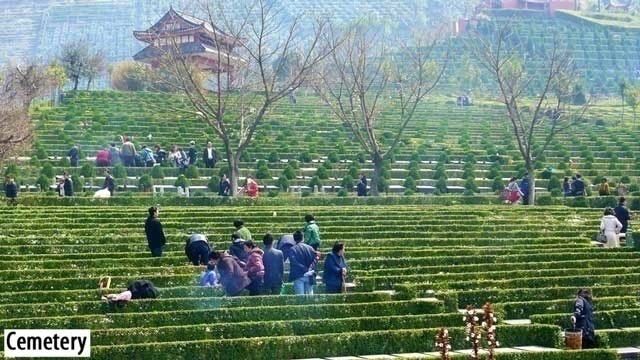
It is in the arena of death that Chinese culture most diverges from Western culture and some of the funeral customs may be a little shocking to those without a better understanding of Chinese concepts like “face” and societal duty.

In general, the Chinese bury their dead.

Cremation is slowly gaining acceptance, particularly in cities like Beijing where burial plots are becoming increasingly expensive due to the shortage of land, but if they can choose they will normally choose burial.

There are certain factors, which influence the burial of a Chinese person and these include their age, their position in society, whether or not they were married and how they died.

It is long established that in Chinese culture someone older or in a position of power should not be seen in public displaying respect or grief toward someone younger or less powerful.

Westerners are often distressed to find that this means that when a child dies no rites are performed and no emotion is displayed at the funeral. They are buried in silence.

Even an adult male who is unmarried may go through the same process. His parents are culturally forbidden from taking his body home from the funeral parlor and from offering prayers for his spirit.

Older people’s funerals on the other hand are gloriously complex and ornate. Many families put themselves into debt to ensure someone is buried with the respect they were given in life.

At home they wrap mirrors and any religious figures in red paper during a period of mourning. This is because they believe that if a dead person’s reflection is seen in a mirror then another member of the family will soon die.
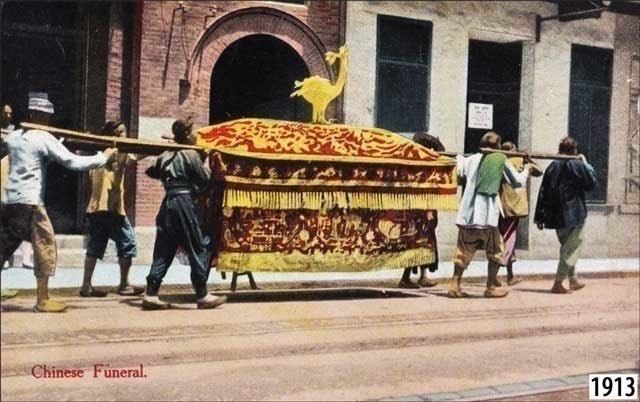
They also place white cloth around the doors of the home. At the main entrance a gong shall be placed to the left of the door for a dead male and to the right for a female.

The body of the deceased is dusted from head to toe with talc. They are placed into their best clothing, which is often bought just for this purpose, and all their other clothing is taken away and burned. The corpse must not be dressed in red for it is thought that this might result in their spirit becoming a ghost.

Funeral ceremonies are long with 49 days of rites held before the coffin is finally placed in the ground. For most families it is the first seven days where the most prayers and rituals will be held.

For rich families, however, the mourning may remain as strict throughout the period. Even once the person is buried the family are required to mourn for another 100 days.

Mourners pin a cloth band to their sleeve throughout this entire time. They must not wear red or jewelry for this time either.

If you are asked to attend a Chinese funeral you should wear black. It is considered polite to leave a small white envelope containing paper money in the robe of the deceased. The money is meant to be used to pay for the funeral.
Traditions relating to lucky colors and numbers
There are a couple of other Chinese traditions that are worth commenting on. These are the traditions relating to lucky colors and lucky numbers. There is a certain level of superstition throughout Chinese culture and these practices are very common everywhere in the country.
Firstly, let’s look at lucky numbers. The luckiest number in China is the number eight and multiples of eight. That’s because the number eight (ba) is a homophone (that’s a word that sounds the same as another word) to the word for fortune or wealth. It’s also because when you write two eights next to each other in Chinese they look very much like the written word for “shining joy.” The number eight is taken very seriously as some people pay serious money for eight and its multiples to appear in phone numbers, license plates, addresses and more. If you ever give someone a red envelope (hong bao) as a gift, it’s really appreciated if the cash inside the envelope is in multiples of eight too.

Then there’s the unlucky number four (si), which is a homophone for the word for death. It’s the equivalent of a Western 13 and you’ll find that many buildings have no fourth floor or even 40-49th floors. Room numbers skip the number four too. Public transport operators also tend to shy away from the number four as it might upset travelers, so it’s not normally found in service numbers for trains, buses, etc.
Every other number is also significant in some way. A good rule of thumb is that even numbers are lucky and odd numbers are not. The number four is an exception to the rule. The number nine however is also an important number as it signifies longevity and is much sought after in contracts or wedding dates.

Now, let’s turn to the lucky colors. These are simple and the first is red – the color for wealth, happiness, and prosperity. It’s used everywhere including on the walls of homes, for lanterns, for bouquets of flowers. Red lanterns are used in festivals. Red envelopes (hong bao) are given full of money as gifts. People wear red during the Spring Festival, when they marry and more.
Then there’s green, which symbolizes money. If you have a quick look at the walls of a local restaurant or bank there’s a good chance they’ll be painted in green and red. That’s double dipping in wealth for the Chinese.
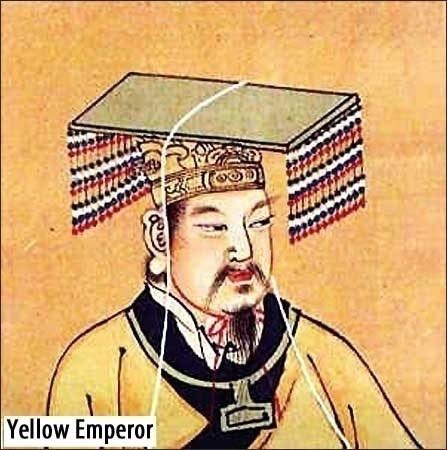
Finally there is yellow. Yellow is a color caught up in the Chinese national identity. The first emperor was the Yellow Emperor. The country is called the Yellow Earth in Chinese folklore. The river, which dominates the country, is called the Yellow River. The people of China believe that their skin is yellow too.
Yellow symbolizes royalty and imperial power. That means it is most commonly found in royal palaces like the yellow glazed tiles on the roofs of the Forbidden City.

Travel guides that show you around and tell stories, not just history.
Dear Traveler, please review this book, we truly appreciate your feedback.
Are you exploring famous landmarks in cities around the world? Are you looking for more insight than a typical guidebook provides you? Perhaps you would like your own personal tour guide but prefer to visit places at your own pace? Are you curious about how people lived in those palaces and castles? Maybe you just want to understand people from different cultures better? Well, we have exactly what you need, we tell WanderStories™.
WanderStories™ is the best local guide for you, showing you around and telling stories of famous and interesting sights, in an e-book on your tablet, smartphone, or computer.
WanderStories™ travel guides are unique because our storytelling style puts you alongside the best local guide who tells you fascinating stories, while a wealth of high quality photos, historic pictures, and illustrations brings your tour vividly to life.
WanderStories™ travel guides are e-books that include lots of photos, maps, and illustrations and tell you the stories behind the history of the places you will visit, like the best personal tour guides would do. In fact, they do it so well that you can visit the most extraordinary places around the world without even leaving the comfort of your armchair. Wherever you are, you can experience the excitement of history being recreated around you as the story unfolds.
You will get to know how real people, emperors and sultans, concubines and eunuchs, slaves and executioners lived in the palaces you will visit; what gods the monks worshipped in these temples; how generals and soldiers, crusaders and gladiators fought and won…or died. You will learn about local traditions and customs, holidays and festivals, cuisine, even jokes.
Whether you’re at home, on your travels, or walking in the historic setting itself, WanderStories™ is the best personal, local guide on your tablet, smartphone, laptop, or computer.
We, at WanderStories™, are storytellers. Our mission is to be the best local guide that you would wish to have by your side when visiting the sights.
Our promise:
• when you visit a city with a WanderStories™ travel guide you will have the best local guide at your fingertips
• when you read a WanderStories™ travel guide in the comfort of your armchair you will feel as if you are actually visiting the best sights in the city with the best local guide
Please get WanderStories™ travel guides at: wanderstories.com
Please subscribe to the FREE WanderStories™ travel e-magazine, Armchair Travel Guide at: wanderstories.com/travel-magazine
Sample from: Shanghai Tour Guide Top 10
Copyright © 2014 WanderStories
Photos and illustrations provided by WanderPhotos™, exceptions are as follows:
Gary Soup is the author of the following photo (attribution license):

All rights reserved. No part of this book may be reproduced or distributed in any form by any electronic or mechanical means, including information storage and retrieval systems without permission in writing from the publisher.
Disclaimer. Although the authors and publisher have made every effort to provide up-to-date and accurate information, and have taken all reasonable care in preparing these publications, they accept no responsibility for loss, injury or inconvenience sustained by any person relying on or using our publications, and make no warranty about the accuracy or completeness of their content and, to the maximum extent permitted, disclaim all liability arising from their use.


